#was watching the rise movie for the 20th time and i saw the scene in Leo’s room where raph is lecturing him and he just
Text
People always start writing about Leo in Fleo fics and try to breach the topic of Leo’s self esteem n confidence issues without actually knowing what makes him tick.
Leo is interesting bc he is entirely aware of what’s going on around him, he’s maybe the best at assessing situations and coming up with an appropriate plan, and that’s what makes him the best candidate for leader! He is good at reading people and situations and he knows exactly how he should be acting as a leader. The issue here- what makes him want to be so irritating and childish is not that he doesn’t understand the gravity of these situations he is creating with his recklessness, it’s that he is insecure and afraid to step up into this responsibility he’s been given. He doesn’t think he’s appropriate for this position, he still wants to let his older brother run things, he is afraid of what it means if he fails this. His brother(s) and father all expect him to do this thing and that scares him. His immaturity and reckless irresponsibility come from a place of sincere insecurity and self esteem/confidence issues. He knows how to be serious. He knows what he should do. He knows when something calls for a more befitting tone. He is good at reading the room, he’s the face man, but he does not want to be seen as a failure by the people he loves, he already sees himself as a failure, he doesn’t want that to show.
I just feel like people forget how rise!Leo is cool bc he is goofy and knows how to press peoples buttons and make stupid puns, and at the same time he is also very capable and skilled and serious when needed. My boy has the range!!
#moth talks#was watching the rise movie for the 20th time and i saw the scene in Leo’s room where raph is lecturing him and he just#he goes thru those expressions and I’m like#AAAGRHJRFHEJ#I love the him#he gives me feelings#rise leo#rottmnt#rottmnt movie
52 notes
·
View notes
Text
Animation Night 130: Hayao Miyazaki’s Aeroplane Movies
Oh that Hayao Miyazaki! We sure have a slightly complicated relationship to him here on Animation Night!
See for example...
Animation Night 70, where I talk about his early career and years as a Toei union man, up to the founding of Ghibli;
Animation Night 100 where I tell you about one of my favourite ever films Mononoke-Hime;
Animation Night 111 where we look at the fascinating My Neighbour Totoro-Grave of the Fireflies double bill of 1988.
Tonight, we’re going to look at two films, Porco Rosso and the controversial The Wind Rises, which indicate his particular arc through life in, honestly, a rather sad way. Putting them alongside each other to see what we learn...
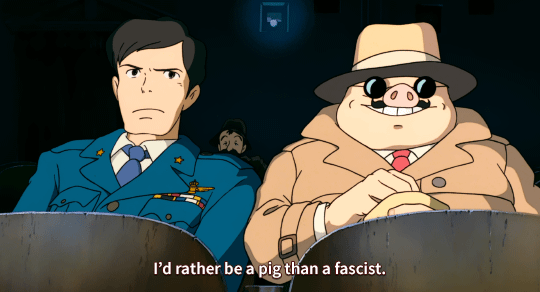
If there’s one thing old Hayao loves, it is aeroplanes - particularly planes from the early-mid 20th century. No surprise, really: his dad Katsuji Miyazaki ran a company Miyazaki Airplane, which manufactured parts for world war II aeroplanes such as the infamous Zero fighter plane. (Put a pin in that one!) Despite working to arm the Imperial Japanese military, Katsuji was able to get out of actually serving in the war by telling his commanding officer that he didn’t want to fight when he had a wife and kid, which somehow got him discharged with just a lecture.
The young Hayao, born 1941, was therefore surrounded by planes, which were the source of his family’s comfort. He spent his earliest years fleeing from American air raids, suffering from digestive problems, and watching his stern, intellectual mother Yoshiko suffering from spinal tuberculosis (though she ultimately made it to 1983, at age 72). At school in the 50s, he took an interest in manga - which in those days naturally meant Osamu Tezuka; he also went to see drama films with Katsuji such as Meshi (1951).

In ‘58, he saw Toei’s Legend of the White Snake (白蛇伝 Hakujaden), notable as the first colour anime film, sneaking out from studying for his exams. The film had a profound effect on him. In Starting Point, he writes that he fell in love with the film’s heroine Bai-Niang, and yet gradually started to imagine how he might have done the film differently to better show the secondary characters.
Hayao went to university to study political economy with a focus on ‘Japanese Industrial Theory’, and at the same time, started drawing in earnest, cranking out thousands of pages of manga and spending a lot of time sketching and chatting politics with his middle school art teacher. The 60s and 70s were a high point of left-wing activity in Japan, the time of the Japanese New Left and the Anpo protests against the US-Japan security treaty (c.f. Toku Tuesday 33 on Nagisa Ōshima for a truly fascinating filmmaker who rose to prominence at this time!) So Miyazaki fairly naturally became a Marxist, and stayed such as he got his start working in animation, which I’ve covered in other posts.

So at this point perhaps we can see the curious contradiction that sits in so much of Miyazaki’s work: he genuinely loves aeroplanes and other kinds of military hardware on a kind of aesthetic level, and yet this sits pretty curiously against a worldview that went from Marxist to environmentalist and has no love of war or nationalism.
With all this in mind, let’s take a look at a few of Miyazaki’s early depictions of planes. First would be his work on episode 21 of Moomin (1969), by TMS entertainment. On this infamous episode, Miyazaki’s senpai Yasuo Otsuka called in his protégé to handle of all things a battle scene with planes and tanks - one which infuriated Tove Jansson, already dissatisfied with the tone of the adaptation, to the point that she pulled the show out of TMS Entertainment and A-Pro’s hands and gave it to Tezuka’s rival studio Mushi Pro instead.
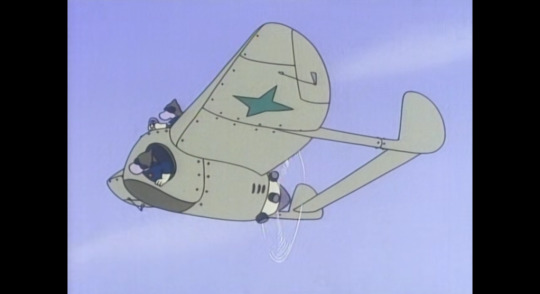
(I can’t find any embeddable version, but I did get my hands on this episode eventually! Lain bless soulseek.)
This did not deter Miyazaki at all. In his work on ‘Green Jacket’ Lupin III Part I, which he co-directed with Takahata and Masaaki Ōsumi as well as animating several scenes, we start to see his love of mechanical detail shine through once more. Miyazaki’s plane obsession would shine through even more strongly with his direction of two episodes of ‘red jacket’ Lupin III Part II (1980), under the pen name “Tsutomu Teruki”, directing animators like the spectacular Kazuhide Tomonaga as @kbnet documents here. By that point his style had matured - the character designs and motion feel like something drawn in Ghibli’s early years, and the plane backgrounds are astonishingly dense with detail. The Castle of Cagliostro is by comparison relatively light on aeroplanes, but truly elevates Lupin’s car to a character - not to mention the film’s ridiculously elaborate finale where the characters battle through an enormous system of gears.
In between these two Lupin jackets came Future Boy Conan, where we start to see Miyazaki find more things to say about planes than “damn cool!”; a full of wonderful plane adventures, yet they also represent the sinister forces of industrialism which destroyed the world once and threaten to do it again.
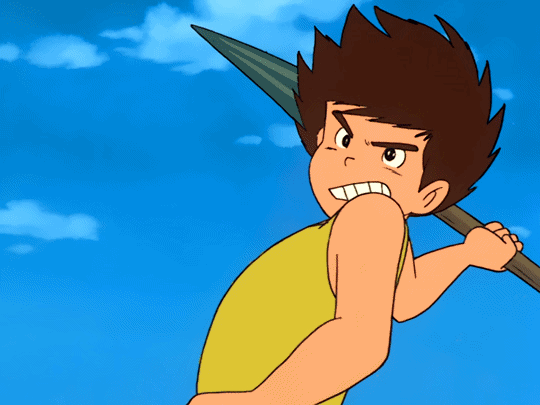
In an essay from 1979 that opens the collection Starting Point, Miyazaki remarks on the qualities needed to animate a plane on Conan, giving a sense of his philosophy around animated machines - and his perfectionism:
Quite a few of toda’s younger animators plunged directly into this line of work because they were fans. But if I were to ask them to draw a picture of what they think a chaika (a flying boat in Future Boy Conan) would look like in flight, they would only be able to imagine what they had previously seen on past TV anime shows. And I wouldn’t be able to use their work as a result.
To draw a chaika flying in a truly original fashion, you would need to have read at least one book on the history of flying, and then be able to use your imagination to augment what you have read.
This is followed by an anecdote about Russian pilot, and builder of the first four-engine biplane, Igor Sikorsky - the man who for Miyazaki “symbolises the way men really fly”.
Miyazaki of 1979 seemed to have a lot on his mind about the relationship of humans to machines. He criticises the mecha shows of the time for a lack of focus on how the character creates and maintains the machine: “the protagonist should struggle to build his own machine, he should fix it when it breaks down, and he should have to operate it himself”. And true to form, when Miyazaki’s films portray machines, there is as much loving depiction of the maintenance as the actual machines in flight.
We’ll fast forward now, since I talked quite a bit about The Castle of Cagliostro, Nausicaa and Castle in the Sky back on AN 70, and Totoro back on AN 111. I haven’t covered Kiki’s Delivery Service yet, although you can trust we will before too long! No, the first film of interest to us tonight is a bit of an oddball in the Ghibli oeuvre; well known to fans of the studio but not quite as much of a household name. That’s Miyazaki’s flying pig movie, Porco Rosso (紅の豚 Kurei no Buta).

^ here’s your obligatory Yoshinori Kanada-animated background animation scene!
Porco Rosso is Miyazaki’s first movie to not just feature planes, but be truly overwhelmingly about planes. Set in a vaguely Mediterranean world, it expresses Miyazaki’s nostalgia for a lost era of flying before he was born, and yet it’s also tinged with the impending horror of the second world war and the recognition that the planes that Miyazaki loves so much are above all weapons.
Unlike many of Miyazaki’s movies, it centres on mostly adult characters and its narrative arc doesn’t really move to any sort of definite resolution; it’s more a portrait of the era, or rather, Miyazaki’s fantastical imagination of the era, in which there can be sky pirate families flying with dozens of children and, of course, a man can get transformed into a pig. The central character of the film, the eponymous Porco Rosso (so called because he’s a pig (porco) that flies a red (rosso) aeroplane), is an outcast due to his pig curse, but also perhaps because he insists on flying for himself rather than for the Italian military, a stance that is already becoming obsolete.
So Porco ends up adopting a young aircraft engineer - a bishōjo character in the spirit of The Castle of Cagliostro - who is eager to see the world. The largest conflict in the film is Porco butting heads with an arrogant American pilot over the affections of Gina, a woman who runs a bar for pilots - yet the two are clearly more similar than different.
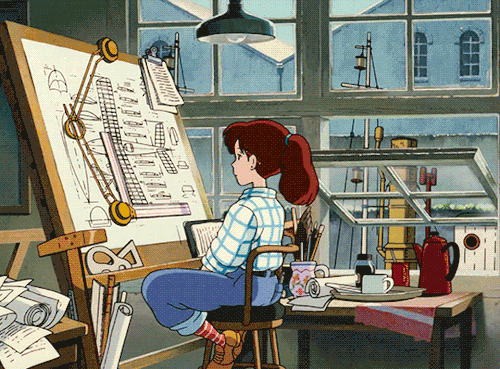
By this point Studio Ghibli is well-established, and Miyazaki can take his pick from some of the best animators in the entire industry. So we see not just Yoshinori Kanada, but also sakuga aces Mitsuo Iso(!!!) and Shinya Ohira(!!!), and with Ghibli money they can truly go all-out. All that attention to mechanical detail, the buliding of machines, is there. Events like the testing of an aeroplane engine are accompanied by incredibly complex multi-layered shots that only a drawing demon like Ohira could accomplish. Only someone whose grasp of 3D form is as precise as Mitsuo Iso could animate some of these shots of subtle wobbles in the pre-CGI era. And on top of that, the colour design of Michyo Yasuda is there in all its beauty, Joe Hisaishi truly came into his own with a score as wistful and nostalgic as such a film demands; it’s an incredibly accomplished work of animation.
But, planes though.
One of the film’s most memorable scenes - one which unites the two films we’re going to see tonight - sees Porco fly up high into the sky to a kind of flying graveyard of aeroplane pilots. It’s here we especially see the ambivalence that obsesses Miyazaki: he finds aeroplanes one of the most beautiful things in the world, idolises their pilots, and yet of course this period of aviation was an incredibly dangerous one, and moreover the aeroplane development was catalysed by war and soon would lead to a level of destruction never seen before in human history with the bombing campaigns of the second world war.
It would be natural to imagine that the workshop where Porco recruits Fio may in some way resemble the workshop run by Miyazaki’s parents - in spirit, as he imagines it, if not in detail. Like Miyazaki Airplane, this workshop in Italy cannot be doing anything but supplying aeroplanes to Mussolini, and indeed we see Porco utter one of the most quoted lines in the film when he tells his old air force buddy “I’d rather be a pig than a fascist.” even though this leaves him essentially a fugitive, on his own with a plane and a girl (like half his age I guess?).
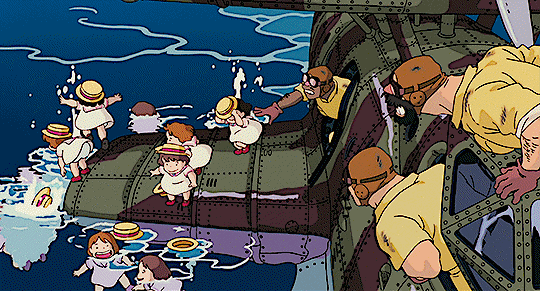
^ This swarm of tadpole-like children was animated by Masashi Ando.
If you actually read Miyazaki’s comments about his dad, it seems a little different. Far from being lovingly crafted, Miyazaki writes, Katsuji would make defective parts and bribe officials to look the other way. He would go to nightclubs right into his 70s and ask Hayao if he’d started smoking yet.
At the time this film came out, Hayao Miyazaki’s father Katsuji would die only a couple of years later, in 1993. We can find a short piece that Hayao wrote about it in Starting Point (page 208-209, My Old Man’s Back):
...And after the war, he had no sense of guilt about having been involved in the military arms industry or having produced defective parts. In effect, for him war was something that only idiots engaged in. If we were going to war anyway, he was going to make money off of it. He had absolutely no interest in just causes or the fate of the state. For him the only concern was how his family would survive.
(...)
When he died two years ago, those of us who gathered together agreed that he had never once said anything particularly lofty or inspiring. If I have one regret, it is that I never discussed things seriously with my old man. From the time I was young, I always looked at him as a negative example. But it seems, after all, that I am like him. I have inherited my old man’s anarchistic feelings and his lack of concern about embracing contradictions.
So the actual reality of aeroplanes around Miyazaki had little to do with the romantic images we see in his films. But that ‘lack of concern about embracing contradictions’ seems important...

In 2013, 20 years after Katsuji’s death, Miyazaki would direct a new film, The Wind Rises (風立ちぬ Kaze Tachinu, lit. The Wind Has Written) - to date, his last film, although of course like clockwork he’s since come out of retirement to work on another one. Ostensibly, this film is a biopic of Jiro Horikoshi, the inventor of the Mitsubishi A6M Zero fighter plane so vital to the Imperial Japanese war machine.
However, if you look into the details, you soon realise that the story present in the film - particularly its central element of Jiro love interest and eventual wife Naoko Satomi - is a complete fiction. Jiro Horikoshi did marry and eventually had five children, but there is very little information about them, even in Horikoshi’s own autobiography. An article comparing the film against it remarks...
The Story of the Zero Fighter is 80% plane design ideas, measurements and stories surrounding Jiro’s career. There’s so much focus on the construction of the planes there’s a measly 20% left for autobiographical material.

According to that article, Horikoshi’s autobiography describes his initial thrill at reports of the Zero’s success in the invasion of China, then later, the psychological impact of a bomb striking nearby and his gradual realisation of what a war actually meant. It’s an arc towards increasing horror at the measures the Japanese Empire was taking to win the war with it, particularly the announcement of the Kamikaze suicide-bomber tactic:
Jiro was approached by the press to write a short essay on the Kamikaze, but he declined. He found it too emotionally difficult to think when he looked at photographs of smiling pilots boarding Zero’s, knowing they were doomed to death. Sobbing, the only sentiment that encouraged him to put pen to paper was dedicating his writings to the families who had lost their loved ones in the war. In the haunted depths of his mind he wondered why Japan had not just given up the war, and why they had gone to such measures with the Zero’s.
Very little of this arc makes it into The Wind Rises. Nationalism is glimpsed only at the margins. In one trip to Weimar Germany, Horikoshi witnesses a Jewish man being pursued; later, he meats a privately anti-Nazi German man at the hospital who talks briefly about how foolish nationalism will make a country ‘blow up’, and his final oblique conversation with the dream-ghost of his idol, Italian aircraft engineer Giovanni Cabroni, about what it means to build planes when they will be tragically be destroyed.
Instead, we find Miyazaki draw in a different source for the primary character arc of this movie: a novel by Tatsuo Hori that also has the title 風立ちぬ Kaze Tachinu. Set in a sanitarium much like the one in which Horikoshi spends the latter half of the film, it tells the story of the relationship between a nameless protagonist and a woman dying of tuberculosis.

It seems an odd connection at a glance: why would you take this seemingly entirely unrelated novel and apply it to an actual historical person? To me, the most plausible answer is that this isn’t really a film about Jiro Horikoshi. Because recall that, of Miyazaki’s parents, his mother also had spinal tuberculosis, and his dad also made planes for the war. Yet, the Horikoshi of this film hardly resembles Katsuji Miyazaki either, who we’ve seen was far from a workaholic like the film’s Jori Horikoshi. Instead, this would better resemble Hayao himself. So instead, it seems to be using this historical setting as a kind of place to explore Miyazaki’s feelings about his parents, his own craft in animation (wedded to the technical industrial world as it is)...
Inevitably that’s a pretty fraught thing to do! More so than any of Miyazaki’s other films, the film sparked a lot of controversy, mostly for how it handles the topic of the war. You could argue that like, OK, do you need a movie to moralistically lecture you on how invading most of Asia was bad? Must it rub our faces in the atrocities committed by the Imperial Japanese Army and Navy to be a worthwhile movie?
One answer is that with the amount of modern nationalism and historical revisionism out there, it might not go amiss for national hero Hayao Miyazaki to take a stand there! But honestly it’s more that, with such subject matter, seems to go out of its way to avoid showing what the Zero was actually used for. The main tragedy, as far as Horikoshi was concerned, seems to be that so many pilots of this beautiful aeroplane die; that his pursuit of engineering beauty was corrupted by worldly matters like a war.
Which isn’t necessarily a completely inaccurate portrait of the real Jori Horikoshi’s attitude to his creation. The quote that inspired the film was “All I wanted to do was to make something beautiful.” But then this film goes out of its way to emphasise Horikoshi as a caring family man, a wholly sympathetic character, when to much of the world, Jiro Hirokoshi is a symbol of....

That. (And that’s the low estimate. It could easily be four times higher.)

But let’s look at how it relates to old Hayao and the contradictions he talks about living. If not to the same degree as old Isao Takahata, Miyazaki is an infamously exacting and demanding boss, heavily correcting nearly every cut that passes his desk. He’s spent his life working at a frankly kind of insane pace and expects his employees to keep up. Studio Ghibli has at least one dead body on its hands. Yet if you look at his films, they’re all about freedom and romanticism and the importance of enjoying nature. In Totoro, the dad is pulled away from his desk to play outside by his children. Probably not a good idea at Ghibli.
Then there are all the family relationships, all the way from the panda in Panda Kopanda to the mother in Ponyo. But Hayao Miyazaki was a distant father (he writes in Starting Point that his children were basically raised by their mother), and infamously callous to his son Gorō when he attempted to direct a film that Hayao didn’t think he was ready to handle.
Can we analogise animation to an aeroplane? It is beautiful in much the same way as an aeroplane is: elegant shapes, the technical coordination of many disparate parts to achieve an effect that would perhaps otherwise sound far-fetched (a flying machine? a picture that moves?). What’s the cost of animation? Well, thankfully nothing comparable to killing millions of people. But it is not a light undertaking. It is something that does eat lives. Is that a comparison that Miyazaki would have had in mind? I doubt it, honestly, but it’s what occurs to me faced with this film.
Thus I read the film’s Jori Horikoshi is a strange emotional blend of Hayao Miyazaki himself, an idealisation of his father or perhaps the sort of man he wishes his father was, and the real man who invented an effective fighter plane which helped enable his country to pillage most of Asia. And the rest of us? Well, the person working through these contradictions is Hayao Miyazaki, at the head of one of the highest concentrations of skilled animators the world has ever seen, so it’s going to be shared with nearly everyone. Would it probably have made more sense to do this in something like a manga, instead of a high profile movie? ...Well, I think so. But that’s not what happened, so we have this movie.

Inevitably for a late Ghibli movie, this film is crazy good looking. No Yoshinori Kanada anymore since he died in 2009, but Shinya Ohira is still alive, and he is absolutely capable of handling a Kanada-like background animation sequence. One of the most breathtaking sequences is the portrayal of the Great Kantō Earthquake by Atsuko Tanaka and Taichi Furumata, which combines both brilliant multiplane shots and unbelievably complex full background animation scenes of waves rippling through houses and streets. Tanaka also handled these mindblowing shots of cloth flowing in the wind as Naoko paints that form the film’s major recurring image.
The film uses slightly more digital compositing effects than the 90s pre-digital Ghibli films. For the most part the colours are just as lush as those older films, and there’s even very effective use of CG with handpainted textures now and then; Ghibli weathered the transition to digital a lot better than many studios.
And yet, despite all of this, it is a movie that leaves me feeling pretty unsatisfied, like a lot of late Ghibli movies. Hayao Miyazaki has said that he’s attempted to move away from familiar kishōtenketsu structures and try something novel, but when I watch films like Howl’s Moving Castle, I’m left wondering like... what did all of that amount to, in the end? For all its spectacle, what is this film even saying that Porco Rosso didn’t say... honestly, say better?
Maybe I’ll find an answer on a rewatch. It’s... far later than I planned to start, but if you’re willing to join me, please hop into twitch.tv/canmom and we’ll watch Hayao Miyazaki’s two big films about planes! And I’ll show you the Moomin thing too.
69 notes
·
View notes
Text
Bat Watch: The Dark Knight (2008)
Watched: 09/18/2023
Format: Drafthouse
Viewing: Unknown
Director: Nolan
SimonUK and I attended a 15th Anniversary screening of The Dark Knight, arguably one of two films that set superhero movies on their current trajectory from 2008 (Iron Man being the other), as DC and Marvel made their way from "huh, superheroes are a fun novelty" to "please stop it with the superheroes".
It has been years and years since I've returned to The Dark Knight (see what I did there?!), and there's a lot of water under the bridge. But it's also a movie I saw so many times between 2008 and 2012 or so that I also have a hard time just slipping back into the movie.
It still has the wildly confusing discussion at the end, that does, in fact, make sense if you squint and go along with the premise of what will, in fact, sway Gothamites to stand with law and order. But it's arguable the film needed to be more clear in the moment. Clearly, Nolan's capable of that messaging - because he really, really sticks the landing on "actually, people aren't murderous trash, Joker, you dick." But that last scene really scrambles on the whole "Batman went on a murderous rampage, not Harvey" bit so that they make Harvey the symbol of justice as a martyred hero.
It's an odd bit of legacy that the Joker is seen as a "mad dog chasing a car". He's clearly not that at all in this movie, but we take what people say in movies at face value instead of literally all of the evidence piling up. He says he's no schemer, but he intentionally gets arrested and sews a bomb into someone's stomach so he can get to the guy in the holding cell in the middle of police headquarters. I mean, that's... wildly more interesting than Jared Leto's dipshit with the face tattoos.
But, man, is some of the dialog in this movie clunky. It's people speaking in trailer quotes and ensuring that their reason for existing as part of this iconography is clearly understood. Some of it works, but, you have to let yourself sink into the fact that this is a modern myth and not someone's attempt at realism. We're conveying *ideas* here, not worrying about Batman's inner-life.
Also - man, does the Batmask not work. I don't know who decided it's essentially a fake nose, but it is. And in close-up, it looks insane and makes Bale's very normal mouth look very not normal. Paired with the Bat-voice, it's a lot.
"maybe I don't want to breathe through my nose..."
Despite all this, Ledger's performance is one for the ages. That's not news. I should really watch that Joaquin Phoenix movie sometime, because I expected it might suffer by comparison, but apparently did not. Who knew this guy would become Oscar bait?
Boner.
heh.
Anyway, I still like the movie. It's not aged into a curiosity quite yet, and it still has massive impact on superhero cinema. If you look at the myth-building and argument of ethical models as the story, I'm not sure it's been topped. After all, we're still crawling out from the DCEU that was formed in its image and from a WB who learned all the wrong lessons from this movie's success. But it also was part of that 2008 one-two punch for a reason.
All that said, I do hope the new Batman movie series and whatever happens with Bats in the Gunn-driven DCU work out.
I'm still blown away we got what we got out of these films. And I am sure in a few years I'll be back here defending The Dark Knight Rises.
https://ift.tt/IAf2Ctr
via The Signal Watch
https://ift.tt/uvlzqEH
September 18, 2023 at 07:33PM
0 notes
Text
My most anticipated sequel
Of the many movies, I’ve seen this one has to be my most anticipated, ‘Avatar: The Way Of water’. The first Avatar movie was released on December 17th, 2009, and was 2 hours and 45 minutes long. When this movie was released I remember going to the cinema to watch it with my parents in 3D, what I hadn’t remembered though was that it came out 13 years ago making me only 5 years old when I watched it the first time. I’ve rewatched Avatar several times throughout these 13 years as it was one of my favorite movies and every time I feel as though I see a part of it I’d never seen before. I recently rewatched the movie again in preparation for the sequel which I have been anticipating for years, the first time I saw a teaser trailer for Avatar 2 was probably in either 2018 or 2019 and at that point in time, I believe the title was ‘Pandora’ which is the name of the plant they are on.
At the end of October and the beginning of November, I realized that Avatar had been showing in the cinema even though its release date was for December 20th, thankfully while I was researching information for this post I fell upon the Avatar movie official Twitter, I realized that they were doing a rerun of the first movie. Since the first Avatar movie was released 13 years ago, it makes sense that the first movie was shown again to refresh the viewers before the sequel will be released.
The director of the Avatar franchise, James Cameron is a Canadian filmmaker most known for making and directing science fiction and epic movies. He played a hand in the making of several blockbuster science fiction movies such as The Terminator saga, the Avatar series, Alien (1996), and Alita: Battle Angel. His plan for the Avatar series is to release up to 5 follow-up movies to expand on the world of Pandora. This movie will have many scenes underwater which is why it took a long time to be released, James Cameron wanted the scenes to look as real as possible so equipment to film clearly underwater needed to be sourced.
The Avatar is set in the 22nd century in the year 2152, and the sequel is set in the year 2166 which is 14 years in the future, according to the trailer, in the sequel we will see Jake and Ney'tiri have a family and explore more of Pandora because of the rise of an ancient threat. This is just a gist of what is going to happen in Avatar 2 because I’ve been trying my best to avoid any spoilers since I plan on watching this movie in the cinema when it finally releases.

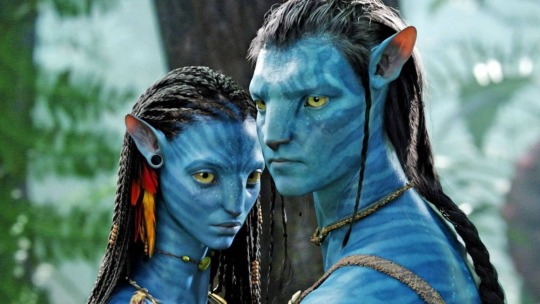

0 notes
Text
FEATURE: 21 Great Anime You Should Absolutely Watch In 2021
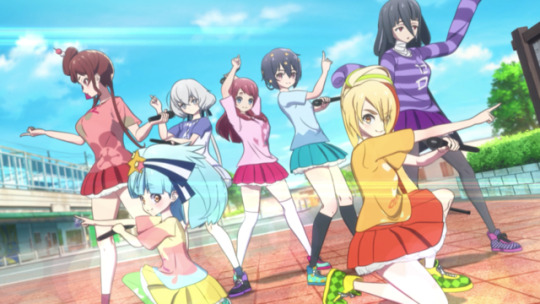
Happy Anime Day! With every season bringing a plethora of new series, there are now countless shows and movies, both new and old, to watch. Whether it's adventure, comedy, romance, or drama you're looking for, here are 21 anime series you should add to your watchlist in 2021.

1. My Hero Academia Season 5
When it comes to the next chapter of My Hero Academia, 2021 couldn't come fast enough. Season 4 showed audiences just how high the stakes really are and how dangerous the enemies can be. Season 5, which recently premiered in March, will not only deliver high-level action, but we'll also get more time with the great slate of heroes and villains showcased last season.
youtube
2. Demon Slayer: Kimetsu no Yaiba the Movie: Mugen Train
After hearing the news of Mugen Train dominating the box office, the time has come for North American audiences to experience this highly anticipated film. Mugen Train will be available for digital release this summer and will help fill the void fans of the series have been feeling since the season ended. And we can always revisit Demon Slayer: Kimetsu no Yaiba in the meantime.
youtube
3. The Devil Is A Part-Timer
The Devil Is A Part-Timer! offers lots of comedy with all the appeal of your traditional fantasy series, but it takes place in the modern world. Demon Lord Satan gets transported to Tokyo, and while his original goal was to take over his homeland of Ente Isla, Satan finds a better path to world domination ... climbing the ranks at the local MgRonalds! It's fun, it's wacky, and it's one of those series we never thought would get a second season, until now.
youtube
4. Given The Movie
Talk about a bag of mixed emotions. Like the series, you'll feel proud and happy one minute, and then a pile of mush the next. Given The Movie provides a touching viewing experience following these fractured characters as they navigate their personal feelings, as well as expressing their innermost emotions through music.

5. Hunter X Hunter
2021 marks the 10-year anniversary of Hunter X Hunter. Whether you've never seen this series or you've re-watched it hundreds of times, come celebrate this epic title's milestone!
youtube
6. MEGALOBOX 2: NOMAD
MEGALOBOX brought all the charm of a '90s anime, but with the story of a futuristic society that takes boxing to a whole other level. Gearless Joe made a name for himself in Season 1, and although things have changed and gotten complicated, he's "not dead yet." For Joe, the fire still burns within him, and he seeks to fight once more.
youtube
7. Osamake: The Romcom Where The Childhood Friend Won't Lose!
Finally, a series where the childhood friend captures the heart of the MC ... I hope? It is a harem after all! Osamake: The Romcom Where The Childhood Friend Won't Lose! has a whole lot of comedy, a whole lot of shenanigans, and a noticeable amount of ... revenge. It looks like an epic competition is about to get underway!
youtube
8. Chihayafuru
If you're experiencing Haikyu!! withdrawals, then Chihayafuru may be the next best sports anime for you! Now don't be fooled. Although Chihayafuru is all about Karuta, a Japanese card game, it still delivers the same level of development and high-stakes settings as other sports anime. This may be one of those series you always saw around but never watched but if there was ever a time to binge, it's now!
youtube
9. Tokyo Revengers
With the manga receiving much praise, probably one of the most anticipated anime adaptations for 2021 is Tokyo Revengers. Motivated by tragedy, Takemichi Hanagaki finds himself in the past, climbing the ranks of the Tokyo Manji Gang in order to change destiny. He may not appear the toughest, but he's determined to get through the intense situations he finds himself in.
youtube
10. To Your Eternity
Knowing this is a story from Yoshitoki Oima, creator of A Silent Voice, To Your Eternity, will surely be an adventure that tugs on your heartstrings. Audiences will witness an intimate journey of life and death revolving around an emotionless orb with no identity but can take the shape of those around it. There will be elements of time, drama, emotion, plus Hikaru Utada performs the theme? ... Sold! Want to know more? Check out the full manga catalog here.
youtube
11. Shaman King
A Shaman King reboot was the best present fans of the original series could've gotten as the title just marked its 20th year since the show premiered back in 2001. Fans will be transported back to their childhood, all the while looking forward to a new story that reflects the manga. The series recently aired in April in Japan, and fans in North America can expect to watch the series sometime later this year.
youtube
12. Horimiya
If you've been searching for a romance anime unlike any other, then you should watch Horimiya if you haven't already. This series takes everything you know about anime romance tropes, and delivers a series of fresh new twists, making for a warm and cozy viewing experience.
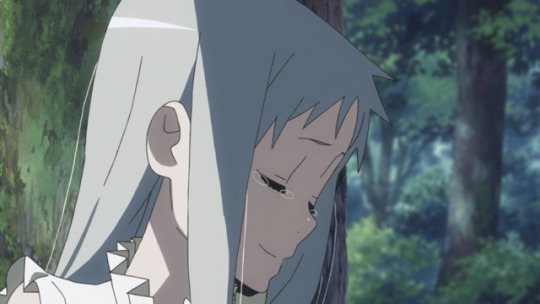
13. Anohana: The Flower We Saw That Day
If in between all the action and comedy you need a good slice of life series about friendship, Anohana is the series for you! The original series aired 10 years ago, but sometimes a trip down memory lane is exactly what you need. Plus a new visual and news of an upcoming project will surely get you pumped to hit play.
youtube
14. The Rising of the Shield Hero Season 2
Thinking he'd be the hero in this new fantasy world, Naofumi Iwatani ended up being hated, shunned, and stigmatized at the beginning of The Rising of the Shield Hero Season 1. But as he journeyed on, he developed genuine relationships, gained valuable trust, credibility, and gratitude from others. Season 2, airing in October, is ready to continue with Naofumi's journey and progression.
youtube
15. Miss Kobayashi's Dragon Maid S
Miss Kobayashi Dragon Maid has it all! This series draws you in with its cute appearance, but it surprises you with its mature moments and shocks you with some unexpected sizzle. Plus it has dragons, maids, and sweet raps! Be sure to check out the second season's adventures this July.

16. One Piece
If you haven't already committed to the legendary behemoth One Piece, now may be a good time to start. The anime is set to hit its 1,000th episode this year, and while diving into a series that's so far along can seem intimidating, if you've been spending a lot of time binging TV lately, this series could be your next big marathon.
youtube
17. S8 the Infinity
Take the Tony Hawk Pro Skater video games, and mix them together with vibrant, aesthetically pleasing animation and cool action scenes and you have S8 the Infinity. Sports anime has been really expanding its catalog lately, and this series is an entertaining addition to the genre.
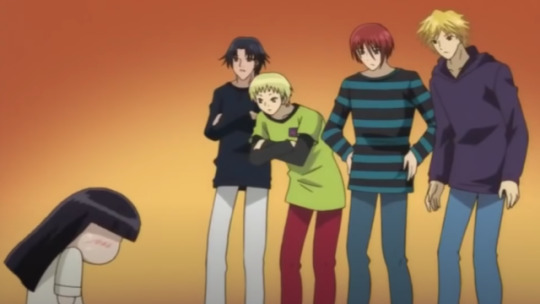
Image via Hulu
18. The Wallflower
A little bit of nostalgia is nice to mix into your anime watchlist. If you're a fan of Ouran High School Host Club, then you'll love The Wallflower! It's got some handsome boys, a cute and quirky girl with a fascination for all things dark and scary, and all the ridiculous antics of a harem!
youtube
19. Death Parade
Death Parade has stayed under the radar, but it at least deserves to be on YOUR radar. A story about the afterlife where a bar represents limbo and its bartender decides the fate of the souls in front of him whether they experience reincarnation, or disappear into the void by playing a game. This is a psychological, thought-provoking drama with some mystery, as we don't know the true nature of the people in the bar, or what led them to where they are. Those secrets will eventually be revealed as the game plays on.
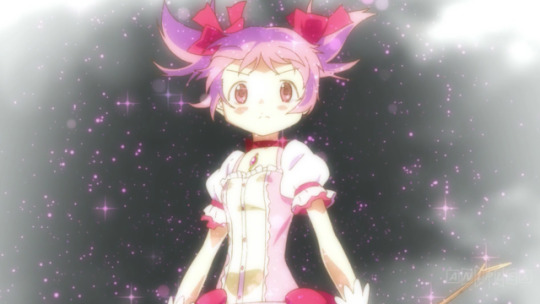
20. Puella Magi Madoka Magica
Like Hunter X Hunter, this year also marks the 10-year anniversary of Puella Magi Madoka Magica. Madoka was and to this day still is a defining series that was a real game-changer for the magical girl genre, showing just how much danger magical girls face. It's a must-watch if you haven't already, so make a contract with yourself to watch or re-watch this series sometime in 2021.
youtube
21. How To Keep A Mummy
How To Keep A Mummy is a heartwarming episodic series to watch when you want to have a feel-good time! Friends and classmates spend time together with their mythical creature companions: A precious, tiny mummy who anytime he holds anything will make your heart melt, a somewhat hot-headed but caring oni, a clever dragon, and a fluffy baku. After catching up on everything on your watch list, have fun with this series to round out 2021.
What anime will you be watching in 2021? Let us know in the comments!

Veronica Valencia is an anime-loving hot sauce enthusiast! You can follow more of her work as a content creator on Twitter and Instagram.
Do you love writing? Do you love anime? If you have an idea for a features story, pitch it to Crunchyroll Features!
By: Veronica Valencia
18 notes
·
View notes
Text

Space Ghost Coast to Coast #85: “In Memory of Elizabeth Reed” | December 7, 2003 - 11:30 PM | S08E04
Happy 20th anniversary, Adult Swim. And, boy, what a momentous episode of Ghost do we have here to celebrate. There are a number of episodes where the guest is an event unto itself and this is truly one of them. Frequent punchline William Shatner is an absolute cunt... and a proper legend. His cuntiness and legendary status are two things that seem to be at odds with one another, and the Space Ghost crew have managed to come up with an artfully idiosyncratic episode to match Shatner’s weird-guy-ness. It’s a classic for sure, and important. But (making a “smug dipshit” face) is it funny?
YES! It’s FUNNY! I will admit though, the first time I saw this episode I didn’t quite know what to make of it. This is partially because I’m very much a Star Trek agnostic. I’ve never been into Star Trek. In the last few years I’ve watched most of the pre-Next Gen motion pictures for inane list-making reasons, and I enjoyed them to varying degrees, but Star Trek is truly not for me. I’m more of a... well, I’m not a Star Wars guy either. What’s the other one? Uh... Spaceballs. That’s it. I’m more of a Spaceballs guy.
But I feel like I’ve absorbed a lot of Star Trek lore through cultural osmosis. I vaguely understand that William Shatner has had some deliberately-paced choreographed fight scene on those rocks from Bill & Ted’s Bogus Journey. When I hear music similar to the the music that Jim Carrey hums in The Cable Guy, I’m pretty sure whatever it is I’m watching is doing a Star Trek thing. And yes, I’ve watched every single Red Letter Media “Mike and Rich talk about Star Trek for 4 hours” video. But even today, after having picked up more Star Trek knowledge on my journey to the grave, I still have this nagging feeling of “I only sort of get this”.
Still, this episode has a handful of screamingly funny lines, and the episode ends wonderfully, with Space Ghost in his death throes, suffering the ultimate indignity of dying in front of William Shatner. There’s also the part where Zorak asks why everyone in Star Trek is black, and a part where Moltar nervously reads from his fan fiction (from a book labeled TARD WARS, hahaha). Shatner, who has a reputation for being arrogant and difficult, is as good a sport as one could hope. The show makes good use of his hammier moments, and only shits on him slightly in the process. The most notable moment is when Shatner says to Zorak “didn't you and I fight to the death?” to which Zorak replies “That sounds pretty dumb, man”. I’ve actually quoted this line many times. It’s one of the best.
Also, for those of you who like to track these things: the show features callbacks to other episodes and shows; the handimen at Zorak’s apartment are clearly extras from Sealab 2020/2021, one of the Leprechauns from Aqua Teen Hunger Force shows up, and there’s a poignant callback to classic Space Ghost episode “Banjo”.
The title motif of this season is naming the episodes after Allman Brothers songs, and I always wondered about this one. Maybe I’m reaching, and it’s probably too disrespectful to be true, but I always thought that it was somehow a veiled reference to Shatner’s wife, whom he supposedly killed or let die. It’s simply too dark to be true, but it’s the first thought that immediately jumped to my mind when I first heard the title of this episode. Am I stupid for thinking this? Am I stupid because it OBVIOUSLY is a reference to that?? I simply do not know. I would like to know.
MAIL BAG
The big anniversary is upon us. What are your 20 favorite things about adult swim for 20 years going. Don't sleep on this question!
I gotta do SOMETHING special, so I might as well do this. More thought could have gone into this, but I spent about an hour trying to come up with episodes or moments from 20 different shows and putting them in rough chronological order. I limited myself to one episode/scene/moment/joke/whatever per show so it’s not all Space Ghost jokes. So, here we go:
Sealab 2021: “I, Robot”. Adult Swim proved it could be brilliant right out of the gate with the stealth premiere of “I, Robot”, but for Sealab it’s all downhill from here. (2000)
Space Ghost Coast to Coast: Space Ghost stops in his tracks to reminisce about the time Bobcat Goldthwait said "crack a window". The entire episode “Kentucky Nightmare” is brilliant, but this moment in particular so uniquely captures my sense of humor that it’s inexplicable. The dumb look on Space Ghost’s face when he stops in his tracks. Goddamn. (2001)
Aqua Teen Hunger Force: “Mayhem of the Mooninites” I tried very hard to make this all be individual jokes or scenes or whatever, but this is another episode where the entire thing is just line after line and I can’t really pick. This, “I Robot”, and “Kentucky Nightmare” is like a perfect trio illustrating how good Adult Swim really was right out of the gate. (2001)
Home Movies: Jason casually reveals that his parents have no idea who Brendon and Melissa are and that he spends most of his free-time making movies with them. This is the episode “Storm Warning” which is overall one of the best episodes of Home Movies, but this scene is probably my favorite. Illustrates how simple and hilarious the comedy is on this show. (2002)
Tom Goes to the Mayor: the end scene in “Undercover”, where they’ve shoddily reversed Tom’s various unnecessary surgeries and called him “Taumpy Tears” to boot. Positively sublime. (2006)
Metalocalypse: Dr. Rockso’s music video. From the episode “Dethclown”. I was never in love with this show as much as the true fans were, but there were a handful of incredible episodes. This episode basically tells one joke over and over and it’s very funny. It really ends with a bang showcasing Dr. Rockso’s shitty music video that celebrates cocaine use. His singing voice is hilarious. (2006)
Assy McGee: I am the only person in the world that defends Assy McGee as being “actually pretty good” and it’s all entirely due to this one line: Assy McGee (a pair of naked buttocks with legs, whose ass functions as his head) is forced to attend a black tie event and is just milling around wearing nothing but a black bow tie. Through clenched anus he delivers the line “I can barely breathe in this penguin suit”. The whole show is worth it for that joke. I don’t even know what episode it is except that it’s from one of the first few. I might not even have the line exactly right. But, I remember laughing so hard. I may not have laughed at Assy McGee again. (2006)
Saul of the Mole Men: The opening theme song. And nothing else. (2007)
Tim & Eric Awesome Show, Great Job!: Jim and Derrick. I should pick something more user-friendly maybe, since this episode almost entirely relies on being familiar with Tim & Eric’s previous episodes. But goddamn, this episode is such a funny concept (which is basically Tim & Eric doing an alternate MTV-ified version of Awesome Show) (2008)
Moral Orel: “Numb”. When Moral Orel suddenly stopped being a quirky Adult Swim comedy and suddenly started doing episodes that resembled art films. This episode is a fucking masterpiece. I remember sobbing the first time I saw it. There are a few in season 3 that are like that, but this one is my favorite. (2008)
Check it Out! with Dr. Steve Brule: Terry Bruge-Hiplo reviews “Dumpster’s Children”. Another bit of comedy that I’d describe as “inexplicable” and “sublime”, and it all hinges on an old man’s mouth. Holy fuck. I don’t think I’ve laughed harder than this at a TV show since. (2010)
Delocated: The ending of “Mole”, an extended Face/Off riff where Jon goes undercover as the scary mobster Sergei. In the final moments of the episode he marries a woman, fathers multiple children with her, and only then is pulled out of the mission. The episode is a tour-de-force of comic acting by Steve Cirbus, who is graciously allowed to shine for most of the episode. But man, that ending is fucking wonderful. (2010)
Venture Bros.: The ending of “Operation P.R.O.M.” a flurry of emotions hit me when “Like a Friend” by Pulp starts playing. The scene is so well done and weirdly touching. Brock realizes that deep down he gives a shit about the Venture family and is genuinely terrified something might happen to them. And then he gets to slaughter a bunch of Zorak monsters, which is also weirdly sweet. It’s even touching on a meta-level knowing that Jackson and Doc tried many times and failed to include licensed music in the show. I love Venture Bros, but I think we’d all be better off if this were the series finale. Sorry. I had to say it. (2010)
The Heart She Holler: The first scene with Patton being taught the way of the world posthumously by his father on a VHS tape. The first season of this show is amazing, but that scene, especially where Patton does a little Japanese bow and says “oh, hot dog!” is just hysterical. Literally every time a hot dog comes up in conversation my wife and I quote it. Please, do not scorn her, it’s not racist when SHE does it. (2011)
Eagleheart: The All That Jazz inspired finale. “Paradise Rising” is mostly a masterpiece, and how it ends is so fucking incredible. Easily the most under-rated show on Adult Swim and I’m not just saying that because... you know (mimes dick-sucking) (2014)
Rick and Morty: I watched the first two episodes of Rick and Morty, thought it was good, but for some reason didn’t become a devotee until my wife made me watch the Mr. Poopybutthole episode. It’s still my favorite episode, I think. (2015)
Brett Gelman’s Dinner in America: The “Dinner with” specials are all really good, but goddamn, this one hits. Should be shown in schools. I am going to go to every grade school in my county with an AR-15 (to get past the guards, of course) and I won’t leave until they call an assembly and they let me fumble around trying to find it on vimeo and play it for the students. (2016)
The Eric Andre Show: Eric interviews Steve Schirripa. The bit where he has an intern dip his balls in Steve’s spaghetti sauce is hilarious, naturally, but I’m here to showcase the running gag where every time Steve complains how hot the studio is, Eric just wordlessly hands him an ice cube until Steve explodes. It’s one of the most childishly hilarious things I’ve ever seen. It’s perfect. (2016)
Million Dollar Extreme Presents: World Peace: The Pick-Up artist sketch. I’m mostly unimpressed with MDE, and all but a few Sam Hyde bits leave me cold. But this sketch is a crowning achievement. I mean, I think these guys suck politically and are more mean than funny, but their sensibilities yielded one really incredible piece of comedy. Okay, I laughed at the blackface sketch too. There. You dragged it out of me. (2016)
Joe Pera Talks With You: This show is beautiful and I love every episode. But the episode “Joe Pera Reads You The Church Announcements” Wherein Joe discovers a new-to-him song and can’t stop listening to it, is one of the most joyous episodes of television I’ve ever seen. A gateway episode. I tell everyone to please watch this one first. (2018)
3 notes
·
View notes
Photo

You may remember seeing Lt. Farrell as one of the many rotating navigators on Star Trek. We saw him for the first time in “Mudd’s Women.”
In production order, this episode would have been filmed before the “The Corbomite Maneuver” and originally Dave Bailey was supposed to have the navigator’s chair. But Roddenberry never knew in which order the scripts would be completed and aired. So to make sure there were no inconsistencies, he came up with the character of Lt. John Farrell in case “Mudd’s Women” aired after Bailey’s departure to stay with Balok.

And actually for a foreground actor, his role was fairly meaty in this episode. The actor Jim Goodwin was a friend of John D.F. Black, one of Star Trek’s Executive Producers as well as the first Executive Story Consultant. Black had often steered roles his way and this part was a good one for Goodwin to display his acting ability.
It appears Lt. Farrell is an excellent navigator at the beginning of the episode. He helps track Mudd’s cargo ship as it enters the asteroid field and suggests they put a deflector shield over it to keep it from being destroyed. A suggestion which Captain Kirk decides to take even though Scotty warns him it’s going to be too much of a strain on the ship.
The revised draft of this episode described Farrell as being “a super-conscious twenty-eight-year-old... red-haired, one of those people who fight to put out 100 percent all the time... which is too much sometimes."
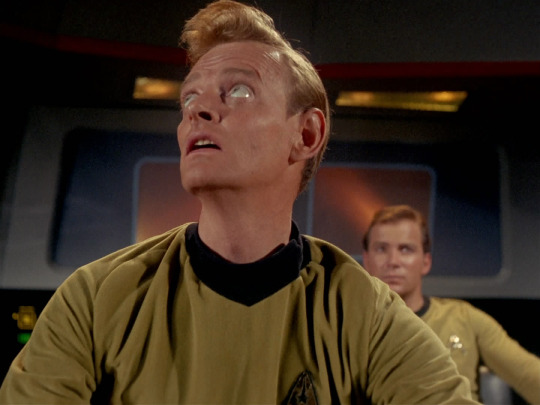
Which means sometimes you get this reaction when Lt. Farrell is a bit nervous ... as in this scene when it appears all the lithium crystals are going one by one.
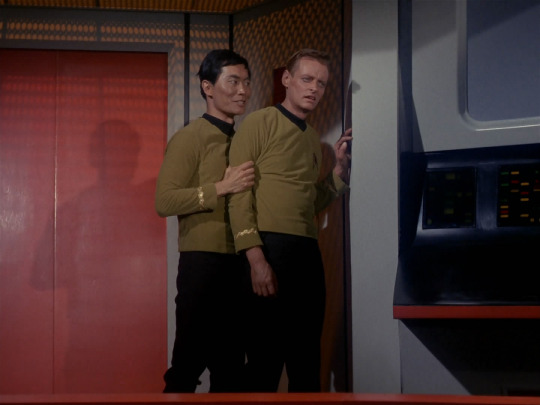
And another one - evidently Sulu and Farrell took a break and were in the corridor when the three beauties sashayed by. As Sulu leads a stunned Farrell back to his seat, he refers to him as Johnny-O. This is the only time we ever hear Lt. Farrell’s first name mentioned. This was not his original first name though. In the final draft, his first name was Jim and Sulu refers to him as James-O in the same scene.
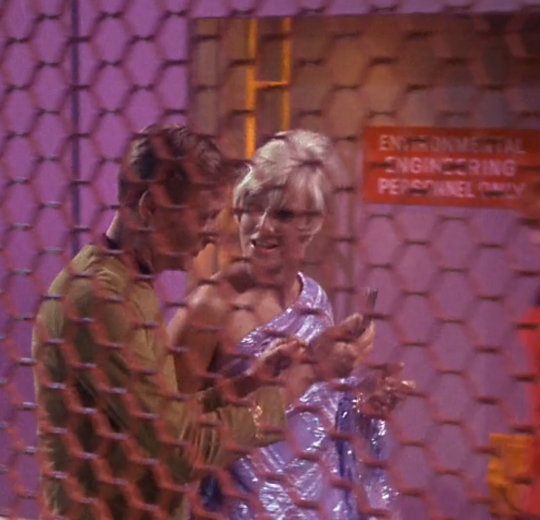
Farrell’s judgment leaves him completely when Magda convinces him to hand over his communicator along with information about the miners. She turns both the communicator and said info over to Harry Mudd which allows him to blackmail Kirk. According to Memory Alpha, there were a few lines cut from this scene. In the final draft, Lt. Farrell tells the charming Magda as they stroll along that he has a girlfriend and also that he wants to grow a mustache. Later in the same version it appears Magda does have a heart when she tells Harry “ "I hope he doesn't get in trouble... he's really very sweet."
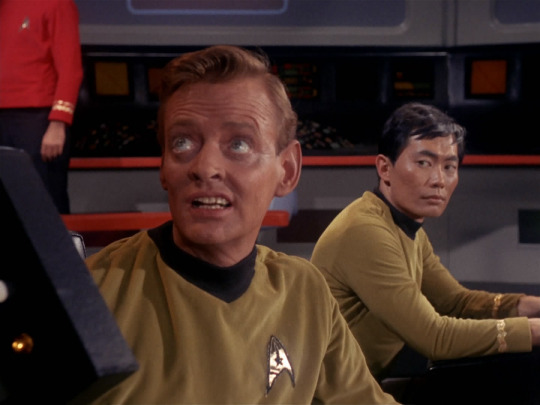
Poor Lt. Farrell can’t seem to shake off the effects of those gazes when the hearing ends and everyone returns to his normal station. He gets dressed down by Kirk because the captain has had to repeat an order twice. Which results in another Farrell wide-eyed expression.
All ends well by the end, of course. Farrell’s composure returns once Captain Kirk returns to the bridge after leaving Rigel 12. But it’s a lot of fun to see how often we see the whites of his eyes as he reacts to whatever stressful situation he is in.

Going by production order, Lt. Farrell appears again as navigator in “The Enemy Within.” (strangely, this episode appeared right before “Mudd’s Women”). There was a deleted scene in the final draft right after Geological Technician Fisher calls for help over the intercom. Spock and Farrell are shown on the bridge listening to his call. According to this script, Spock bolts for the turbolift doors and yells back for Lt. Farrell to take over.
Alas, as mentioned, that scene was dropped. Which is a shame because it again establishes Lt. Farrell as someone who is competent and has the respect and trust of both Captain Kirk and Mr. Spock. He’s not just some overwrought officer who makes goofy faces.
Instead, we don’t see Lt. Farrell until almost the end when the Evil Captain Kirk enters the bridge and sits in the Captain’s chair. Farrell’s above expression comes from Evil Kirk’s orders to leave the planet, even though that means stranding the other members of the landing party in sub-zero temperatures.
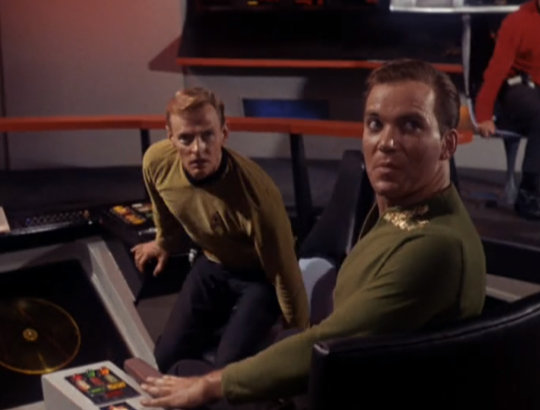
About this time, the real Captain Kirk along with Dr. McCoy walk onto the bridge from the turbolift. Knowing he has to act fast, Evil Kirk orders Farrell and James to arrest what he says is the imposter.
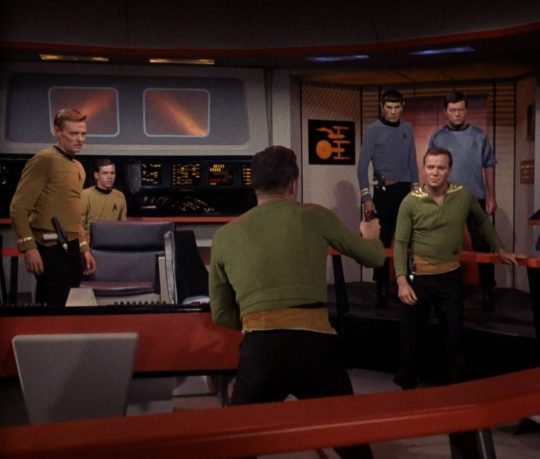
Once the real Kirk begins advancing toward his evil counterpart, Farrell is really confused and just freezes in position. At one point, he plaintively asks Mr. Spock what to do but Spock ignores him as he watches the drama play out.
Notice that our Lt. Farrell is the only one who seems to actually rise or make any attempt to get up out of his chair during this scene. Another sign that despite his shortcomings in “Mudd’s Women” he really is a fine office.

About the time “Miri” was beginning to be filmed, John D.F. Black decided to leave the show. Which meant Jim Goodwin no longer had his friend and sponsor to steer roles his way. Lt. Farrell appears for the last time in this episode, although he is not in his traditional navigator seat. He has taken Uhura’s place at the communications station (Nichelle Nichols was considered a day player, not a contract player. So we did not see her in every episode).
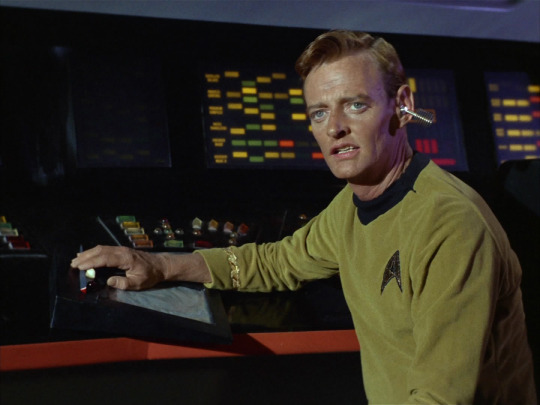
But Lt. Farrell does play an important role in this episode. He is the one who relays all the information Spock gives him into the ship’s computer in an attempt to find a cure for the deadly virus that affects the inhabitants once they beginning entering puberty.
Even though Jim Goodwin was assigned to roles originally meant for Anthony D. Call and for Nichelle Nichols, he was also on the receiving end of having parts meant for him given to other actors. Farrell had scenes in the first drafts of both Charlie X and The Naked Time. By the final draft, however, his part in Charlie X had disappeared. And his part in “The Naked Time”? It was assigned to a new character named Kevin Riley.
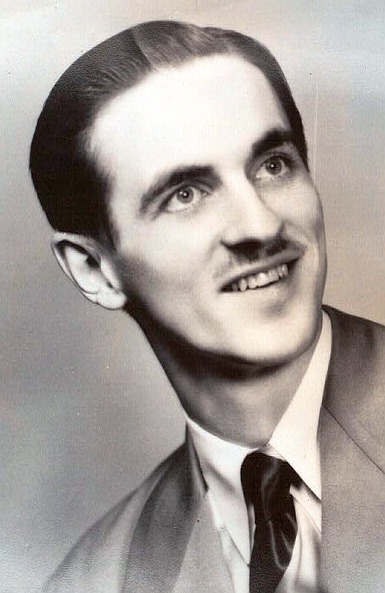
Jim Goodwin came to Hollywood by way of Boston, Massachusetts. He had begun his acting career long before Star Trek, making his first appearance in 1950 on the TV show Starlight Theatre. After that, he had a fairly steady stream of small parts in both television and film.
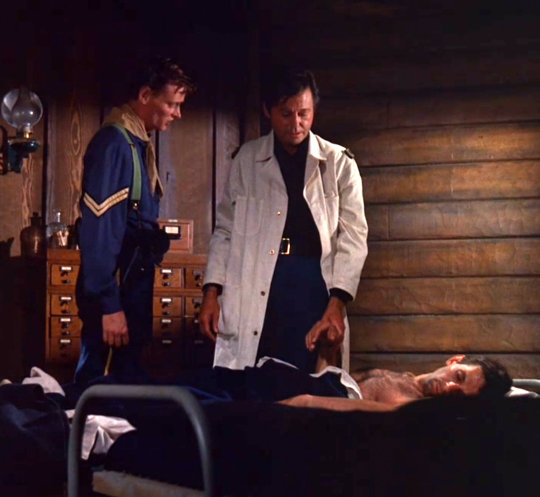
Before Jim Goodwin was seen on Star Trek, he had small parts in two episodes of a popular television western called The Virginian. In “A Man of Violence” he played the role of Corporal Perkins. The teleplay was written by his friend John D.F. Black. In the same episode, DeForest Kelley was cast as Lt. Beldon, the medical officer for the camp. And Leonard Nimoy played a bad guy named Wismer (seen above lying on his side).
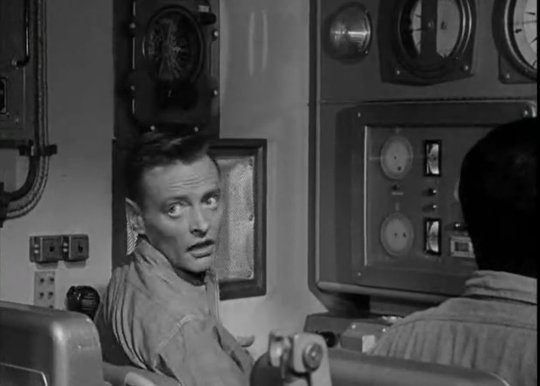
Also before Star Trek, Farrell had two appearances in 1964 as a helmsman in the sci fi TV series Voyage to the Bottom of the Sea. The above screenshot is from the episode “The Invaders.”

As mentioned earlier, Goodwin did have small parts in a number of movies, including Ice Station Zebra (1968), The Reivers (1969), and Emperor of the North (1973), in which he played the part of Fakir (see publicity photo above). This would be his last movie, although he still was active in television up until 1979 and ended his career with a total of 50 credits.
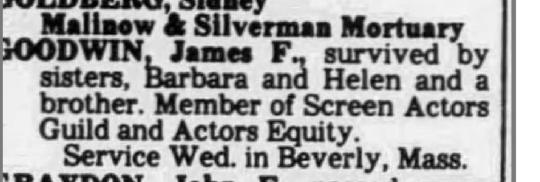
Sadly the year after his last film, Jim Goodwin’s death notice appeared in the Los Angeles Times on May 20th, 1980. It is quite scanty but since he was not buried in L.A., it is possible that a larger obituary was seen in one of the papers from the Boston area and from Beverly, Massachusetts.
There does not seem to be any information about Jim Goodwin. Many Star Trek extras had other careers or jobs on the side and continued those when the acting parts began running dry. This may well be Jim Goodwin’s story as well. No mention was seen of him ever appearing in a Star Trek convention, which is a shame, because certainly avid fans would have remembered him and been interested in hearing about his days on the Star Trek set.
31 notes
·
View notes
Text
Scones and Sticky Notes
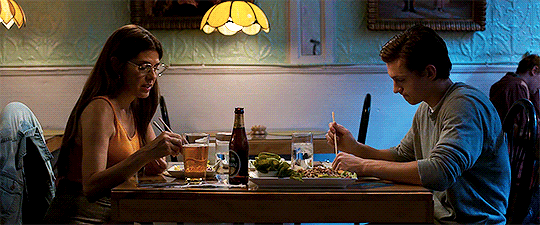
Ship: Peter Parker x Reader
Warnings: Like two swears, a cheesy pickup line
A/N: Heyyy so I really like this writing of mine!! It’s a lil in the future and DOES NOT contain any spoilers for FFH, you are safe!! Please enjoy!!! Also a little P.S that requests are open!
It was the day. Peter woke up early for today. It was a routine Friday to everyone else in Queens. A regular day to anyone except for Peter. Today was December 20th, the day he's been anticipating since mid-April. Star Wars: Rise of Skywalker has officially been released in theatres, and Peter was every form of the word 'excited'. Exhilarated? yes. Enthusiastic? Definitely. Eager? Without a doubt. He's counted down to this day for months, Ned has been too. Peter and Ned adored the franchise, they had annual movie marathons just for the enjoyment of it.
Peter spent weeks convincing May to let him skip school to see it. He gave her plenty of reasons why he should go, he thought they were indisputable.
"I'm far ahead of my work, Aunt May!" He told her last Tuesday when she was plating Peter's chicken. This was his last shot, she kept denying him, so he saw this as his last chance. All she did was nod and tell him she's think about it. His wide smile faltered a bit, showing some obvious disappointment.
"I'm kidding," Aunt May said with a mouthful of potatoes sticking in her mouth. "Of course, kiddo!"
He thanked her at least twelve different times throughout their dinner. She told him each time that he didn't need to thank her. His grades were good, and he was right, he was far ahead of his work. He merited a little mental health day.
Once dinner was done Peter rushed to his room and texted Ned.
'BRO! She said yes!! We're going!'
Ned quickly scanned the text and replied at sonic speed.
'Sick! See you next Friday!'
It all felt like yesterday, but at the same time, the day couldn't come soon enough. But now it was here!!
Peter looked to his left to look at his alarm clock, 6:47. Perfect, he had about 2 hours until their movie showing. Peter lept out of bed and made a beeline to his closet. He looked at each of his shirts on the railing of his miniature closet. If he wasn't satisfied with it, he'd push it to the right with a high pitched screech from the hanger's friction with the railing. After going through what felt like 20 shirts, which was truly five, he found the perfect Star Wars graphic tee. He threw it on his bed, which landed on his pillow, and shuffled to his drawer for some pants. Peter just grabbed a pair of distressed blue jeans and flung them on the bed too, this time settling on the latter to his top bunk.
After selecting his clothes, he grabbed them up and carried them to the bathroom. He passed through the kitchen, which was filled with smoke. Wait....smoke?
"Sorry, Pete. Scrambled eggs didn't work out so great this morning." Aunt May chuckled.
This situation might be concerning in any other household, but to Peter it's normal. Smoke in the kitchen is like watching TV, it just happens but you don't question it.
Peter grinned at Aunt May. Despite her untalented cooking techniques, he still appreciated it nonetheless. "It's alright, I'll bring home some scones after the movie."
"Thanks, Peter"
"I'm gonna hop in the shower, shout if you need me or something," Peter shouted while closing the bathroom door. He had his entire morning planned out in his head. He'd shower, get dressed, so his hair, pick up Ned and then go to breakfast. Time for step one.
Peter walked briskly down the street, Ned by his side. They were on a mission to get to the cafe down the street, which was cleverly named It Dough Matter. Ned was doing some rambling about how excited he was for the movie. Peter was listening, he would never not listen to Ned, he was just a tad distracted with getting to the cafe on time.
As they walked in, the smell of coffee and cinnamon flooded the boy's senses. It smelt like heaven.
"I'm gonna find us a seat, I'll text you my order," Ned suggested while departing from Peter, who was already standing patiently in line. Peter gave him a small nod and continued to overthink about the movie.
Once Peter found Ned at their table, he placed the two coffees, muffin and raspberry scone down on the table. It was a table next to one of the large windows the cafe had. It showed the local population, the convenience store, the bank and the small flower shop everyone visited during prom season. Peter sat in the wooden chair, handing Ned a napkin and his muffin.
"This is the cleanest one I could get," Ned said to break the silence. "It's a nice view though." He added.
Peter looked at Ned and nodded again because he was suddenly at a loss for words. Right behind Ned's shoulder was a girl sitting at the booth directly behind the teenagers. She was absolutely breathtaking.
Ned waved his hand in front of Peter's face slowly. "Hello? Earth to Peter?"
Peter leaned forward, waiting for Ned to lean into the middle of the table. As Ned leaned down, Peter put a finger over his lips to tell Ned to shut up.
"There's the most stunning girl right behind us," Peter whispered, making sure he had Ned's full attention.
"No way!" Ned exclaimed as he turned around.
"SHHHH!" Peter hissed as he grabbed Ned and turned him back around. "I think she's wearing a Star Wars tee. Do you think she's going to the same showing as us?"
"Bro! Probably!"
Peter nodded for the third time today, not because his mind was full, not because he thought it'd be a good response, he was simply at a loss for words.
Butterflies filled Peter's stomach as they approached the theatre. This is the moment in his life where he feels like he could die because of being excited. Ned shuffled to the ticket man first. He handed the man his ticket with a shaky hand and took it back once he ripped it. "Enjoy the movie!" The man said. Peter was next. He offered the awkwardly dressed man his ticket and took the ripped ticket back in one motion.
He met Ned next to the bathrooms. The neon lights shone on Ned's skin making him look like a mediocre Darth Maul cosplay. Peter laughed, and Ned laughed with him. Ned understood Peter wasn't laughing at him, and it was funny to him because Peter also looked like a bad cosplay of the underrated villain.
"Ready?" Peter asked, his voice laced with enthusiasm.
"Ready," Ned replied, fist-bumping Peter as the duo walked to their theatre.
Peter looked down at his ticket while they still had light. He was in seat H09. Ned was in seat H08, so Peter couldn't help but wonder who H10 was.
Peter opened the door, holding it for Ned who thanked him as he stepped past the trash can and into the theatre. Peter followed suit, walking with some pep in his step as they approached their seats. Once Peter got close enough to H09, he saw who was sitting in H10. Holy shit. It was the cafe girl!
Peter turned to his right and tapped Ned on the shoulder. "Don't freak out but I'm sitting next to cafe girl."
Ned laughed, he noticed the slight tint on Peter's cheeks, even in this dark theatre.
"You better make a move or I will."
Peter slowly walked towards his seat. "Is that a challenge, buddy?" He whispered.
"You bet your spidey-suit it is," Peter smirked at the comment.
Peter then sat in his seat. Even though his jeans, he could feel the rough cloth of the cheap seat. Not that it was a big deal. He wouldn't let a seat ruin his Star Wars day.
"Next time, bring a blanket or a sweatshirt to sit on, this theatre sucks," A feminine voice to his right stated.
Peter's eyes widened, panic set in. His butterflies were let loose for a different reason this time. He could feel the heat rising to his cheeks.
"Cool," He said.
Cool? Peter Parker how stupid are you?
"You just blew it," Ned muttered in his ear. "You sounded like a total douche!"
Peter groaned. "Thanks, Ned,"
The previews started playing, advertizements to buy Skittles or to get a Regal Cinemas gift card. Nothing Peter hasn't seen before.
"Twizzler?" The cafe girl offered. She outstretched her hand towards Peter and looked down at them.
"Sure!" Peter smiled, taking one from the cafe girl's hand.
She beamed at his acceptance. He noticed, of course. She looked beautiful when she was smiling. The way the movie screen lit up her features, smile or not, was mesmerizing.
"I'm Peter...by the way,"
"Nice to meet you, Peter, I'm Y/N!" The cafe girl, now named Y/N, cheered. "I think I saw you at It Dough Matter earlier, is that right?"
"Yeah! It's one of my favourites! Their scones are some of the best in the country." Peter insisted.
"Tell me about it, man! I am obsessed with their blueberry scones!" Peter giggled like a school girl. Not only is this girl beautiful, but she loved scones. She's perfect!
Peter felt Ned nudge at his elbow, but he didn't really care. He was too busy looking into Y/N's beautiful eyes to give a damn. They were just so, amazing. He could write an essay about her eyes.
"Well," Y/N said, "It looks like the movie is starting. If you talk, Peter, you're dead to me."
Peter laughed and turned his attention to the movie screen.
The audience cheered when the credits started rolling. That was amazing! Y/N got up and placed a sticky note on Peter's large Coke that he was drinking. He was too busy to notice though. He and Ned liked to stay for the credits, just to show some appreciation to those behind the scenes. However, once they were done, Peter shifted to his left to be greeted with emptiness. Y/N left. Odd.
He looked down though, at his cup. To see a sticky note. That's...different. He opened it to see a small drawing of a lightsaber and a little note next to it. It had a number.
You're the Obi-Wan for me ;) -Y/N
#peter parker x reader#reader x peter parker#peter parker#spiderman#bucky barnes x reader#bucky x reader#steve rogers x reader#marvel#mcu#fanfiction#marvel fanfiction#marvel oneshot#oneshot
189 notes
·
View notes
Video
youtube
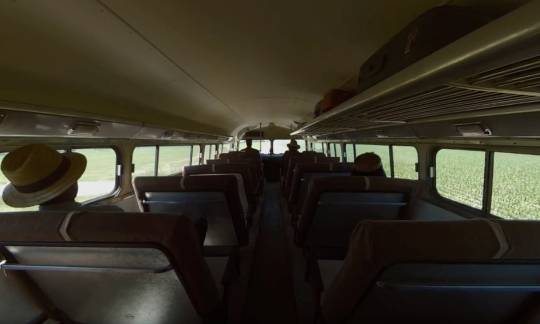


Traveling While Black: behind the eye-opening VR documentary on racism in America
In the Emmy-nominated virtual reality project, viewers are given an immersive historical experience on the depressingly topical dangers of being black in America
The theatre has luxurious red velvet upholstered seats, grand ceilings and gilded trimmings. The rows of chairs stretch back into the ostensible blackness, with light beaming from the projector room. Ahead, archival footage of stylish black travelers pack the screen as an unseen narrator discusses the hardships of mid-20th-century black travel. Enabled by modern technology but trapped by racist social convention, their trips were eventually greatly eased by the publication of the Green Book, which listed safe spaces for black people to sleep, eat and replenish.
A car gradually appears next to the stage in black and white and a Green Book institution, Washington DC’s Ben’s Chili Bowl, comes into view. The seats have dissipated into a silent, empty U Street. For the next 20 minutes, the viewer will journey through the traumatic stories lent to Emmy-nominated virtual reality documentary Traveling While Black, which discusses the agony and trepidation of a people moving through a country that has not fully accepted them.
Traveling While Black is the first virtual reality project by Oscar-winning documentarian Roger Ross Williams, in collaboration with virtual reality studio Felix and Paul Studios. Glued together by the deep terror of racism, the documentary relies on a collection of interviews and poetic cinematic recreations to tell the harrowing tale of the danger that comes with having black skin.
Originally developed from a play as a multimedia project, someone suggested it might take better life as virtual reality project. Even so, its initial development was rocky. “It was tough figuring out the landscape because everything is so new,” Williams said. “At one point, this piece was going to be animated. At one point, we wrote a script and were talking to actors...���
But all parties agree that the story works best told through documentary film-making. “Documentaries are a lot more immediately mature as a medium of virtual reality, as a genre, as a format than fiction. We saw that this was too sensitive of a shoot to be experimenting with,” said Paul Raphael of Felix and Paul Studios. “We really wanted to do the material justice. It’s not the kind of subject you want to approach and not be respectful of.”
In the documentary, the aforementioned Ben’s Chili Bowl acts as a heartbeat of black DC, presenting itself as a central location for black travelers and locals alike. The virtual experience elucidates the concept and reality of an enduring safe space, too often stripped from black citizens.
Virginia Ali, the owner of Ben’s Chili Bowl, relays the history of the building as a black space, an old copy of the printed Green Book resting on the table of the booth before her. Ben’s Chili Bowl is the third iteration of the space, she says, originating as a silent movie theatre, then a pool hall, and finally, into the restaurant and institution where Barack Obama once visited for their famous half-smoke.
“From the very day that we opened, until the current time, it’s still a safe haven for people,” she asserts gently. To Williams, Ben’s was a natural choice to set a documentary. Ben’s encapsulates the combination of black ease and discomfort alike. “We wanted to basically take people back to the time when they needed the Green Book and they needed spaces like that. We wanted to connect that to the present because we still need spaces like that to show how much hasn’t changed.”
In the documentary, like in the lives of black Americans, there is nowhere to turn away from the horrors of racism. It besieges the viewer in its inescapable cage.
“If you’re not African American, you get to go into a space and be part of a conversation that you probably normally would not be privy to. If you are black, you get to delve deep into that inner trauma that we all carry with us in America as black people. I think that’s really powerful in the way that 2D storytelling can’t provide,” Williams said.
Raphael agreed, saying: “In virtual reality, you get to actually feel like they are there in front of you, much more strongly than by watching them on a flat two-dimensional rectangular screen. So that really changes how receptive you are to anything that is presented to you.”
But he admits its all-encompassing nature also poses a challenge. “[It] also means you have to recalibrate how you tell the story and what you present to the viewer. You could actually overwhelm a viewer very easily and have them shut down,” Raphael explains. “So it’s a very interesting and beautiful medium to work with. You need to be careful with it, but when you do it right, you can affect people in a way that I think is out of reach for cinema.”
The experience allows for the past and present to be presented in juxtaposition, merging to validate one eery conclusion: the problems of the past have not subsided. Former Student Nonviolent Coordinating Committee activist Courtland Cox contends in the documentary: “The assumption is that, at some time, it stopped. And that’s not the case. It never stopped.”
The creator of the Green Book, Victor Green, once said that if the guide went out of print, black people would have reached the proverbial mountaintop of equal opportunity. Traveling While Black directly challenges that. “It’s different, but we are still in danger as black people when we step outside of our doors,” Williams said. “I could be walking down the street in my own neighborhood and be killed.”
Indeed, the fears aren’t exclusively relegated to the bus or the train or even distant travel, says Williams. The documentary highlights one such example: the tragic extrajudicial murder of 12-year-old Tamir Rice, told through his reticent mother, Samaria, who describes the day for the first time to an audience inside the restaurant.
She was at home, when, only a short distance from his Cleveland home, the officers shot her child within seconds of their arrival on scene. He was unarmed. The video of the entire police encounter only takes a few seconds, wherein the viewer is whisked back to the movie theatre, ushering a sense of disbelief and removal from the horror on screen. When the viewer returns to the booth where Samaria is still seated, several of the patrons and servers are in tears.
“I will never get that vision out of my head,” she laments, telling the somber yet captive audience how she was restrained from being with her child during his final moments by the same force that took his life. Fiddling with her napkin nervously, she continues: “I wasn’t finished raising him. I wasn’t finished nourishing him and America robbed me.” When asked what the American dream is to her, she replies: “A nightmare. Especially if you black.”
“I wonder, when does it end?” Sandra Butler-Truesdale, a fifth-generation DC resident, ponders aloud in the experience.
It’s the kind of question Williams wants the viewers to ask after the experience. He understands the material will not carry the same weight to different groups but does believe in its power to start an honest conversation.
“I think that if you are not a person of color and you watch this film, you walk away transformed. You walk away [and] you feel the sort of empathy and the pain really that black people carry with them in a country that hasn’t confronted the reality of racism, in fact, in a country where racism is on the rise … As a black person, I want you to walk away and want you to have open and honest conversations with people in your community about that trauma. It’s like therapy. We need to talk about it.”
[youtu.be]
Photographs:
Traveling While Black, a virtual reality documentary, discusses the agony and trepidation of a people moving through a country that has not fully accepted them
Ben’s Chili Bowl in Washington DC acts as a safe space for black travelers and locals alike
#traveling while black#roger ross williams#the green book#green book#virtual reality#racism#white supremacy#amerikkka#video#youtube#washington dc#ben’s chili bowl#felix and paul studios#the guardian#documentary#documentaries#victor green
4 notes
·
View notes
Text
Michael Fassbender & James McAvoy Interview
Source: Moviestar 02/19 (174) June 2019 (Germany)
Interview by Claudia-Janet Kaller
Translated by fussingoverfassbender
I apologise for any mistakes.
Finally it’s here, we had to wait a long time for it: Dark Phoenix, the story about the final transformation of the young mutants into the X-team as we know it. The dark phoenix let us wait, but comes back with a impact which lets us forget that.
After the presentation of the first completely finished scenes, Claudia-Janet Kaller had the possibility, thanks to 20th Century Fox, to talk to James McAvoy and Michael Fassbender for Moviestar in London.
Moviestar: How much of the movie have you seen so far?
James: Nothing! Absolutely nothing! I only know the trailer that was released one week ago.
Michael: I only know the trailer too. But it’s still very soon, which means they are still working on most scenes. It’s always like that at this kind of film.
MS: Okay, but in the trailer you look good!
James: (laughs loudly) Fantastic! I actually always look good in trailers, but I love hearing it again! That’s the goal of every film - looking good in the trailer!
Michael: (nearly rolling in the aisles) Right! Super trailer performance, James!
MS: Does that also count for the trailers in which you gotta wait before the next scene is filmed?
Michael: (keeps laughing) Hey, good joke! Trailer and trailer!
James: You mean the trailers we hang out in?
Michael: (won’t stop laughing) Have you got another trailer; James?
James: (chunters) All right!
Michael: No, seriously, I don’t like watching trailers! I also dislike reading reviews or summaries. In the end everybody has their own opinion. I may like things that others don’t. I like watching films completely unprepared. I wanna be surprised, wanna discover the film for myself or find it bad. That 100% film experience is very important to me, because I don’t have much time going to the theatre.
MS: How do you pick the movies you’re watching?
Michael: I mostly read about who made the film, what kind of film it is, where it’s set, and what else is on. It’s often also the theatre I select. Is it a small arthouse cinema, it’s certain from the beginning that I won’t watch a blockbuster there.
MS: Why are you doing it like that?
Michael: The reason I do it like that is an easy one. Years ago I’ve read a review about The Big Lebowski. The critics had given it barely three out of five stars. Then the film was released on DVD and I finally saw it. To me, The Big Lebowski would have deserved more than five stars, until today it is still one of my favourite films.
James: I agree on that! Many reviews annoy me. Because often the critics haven’t seen the film, but write reviews as if they knew it. Some magazines only rewrite preexisting texts, also not very thorough. There might be many reasons for that, but it rather damages the film instead of helping it.
Michael: What I also dislike with trailers is that you already see too many things that happen in the film. People always speculate wildly then. Each shadow or glimmer of light is getting analysed...
MS: Let’s talk about this fourth joint movie; is this the movie where Erik Lehnsherr and Charles Xavier go separate ways in the end?
James: Wasn’t that already the last one?
Michael: No, there I helped rebuilding the completely destroyed house.
James: Oh right! Thanks for that, by the way, or else the X-Men wouldn’t have had a house this time.
Michael: See, I’m important for the X-Men!
James: (laughs again) Yes, so the characters are still talking with each other. We’re in the 90s now, so I probably send Erik e-mails.
Michael: (laughs too) No, I don’t think so. WiFi didn’t exist yet. More like letters in bottles from Professor Xavier.
MS: It looks like Magneto is repairing cars on a junkyard, doesn’t it?
Michael: (laughs) Sure, I love repairing cars! There so much metal in them, it’s one of my easiest exercises. Each twisted car, Magneto bends it back. No, seriously, Erik has established Genosha in the meantime. We - Magneto and other mutants - live in that independent nation for people who feel unwanted or are refugees. As long as those people blend in the group and work harmonically there for the community of Genosha, it is their home.
MS: Does that only count for people with special powers, or also for those without?
Michael: A justified question, I’ve been thinking about that too. That is surely the shadow-side of Genosha. It’s a pure mutant haven. While Professor X stands more for the mutants integration with the humans, Erik is the one who rather stays among mutants. He has experienced so many bad things with humans, he doesn’t trust them anymore. At this point of time, he has nothing against cooperating with humans, but that’s it. In the end he wants to keep both groups separated. That’s what’s so fascinating about this comic area, we can talk openly about topics such as building walls, separation, etc. In my eyes it’s very important, especially now that everything somewhat starts to separate, dissociate, building walls, etc. It may sound strange, but if there is something those fantasy-films serve as well, it’s surely to talk about such recurring phenomenons and to point the finger at them. One can only hope that many young people will watch that film and understand what such dissociations can cause. We have to watch out what happens to us and how we are being manipulated! To capture that zeitgeist has always been the strength of all X-Men films. I think it’s good we did it again.
MS: You’ve known each other for more than ten yours through that work?
Michael: Longer!
James: If I calculate correctly, it’s been twenty years. But that really does sound like a long time...
MS: What was your chemistry on set this time?
Michael: Terrible! There barely was any!
James: Yes, really terrible! We barely worked together, were almost always separated. I had my school, my mutants, and my problems. Erik had Genosha, his mutants, and his problems.
Michael: (laughs again) Yes, we only met during lunch oder between the studios. Short Hello and how are you, nothing more. During X-Men: Apocalypse it was better, we were stuck on a mountain for two weeks.
James: (laughs too) Right! You looked like a glamrockstar! While I looked like I had come straight out of Miami Vice, with the light suit and dark shirts. Bald Sonny Crocket!
MS: Okay, let’s ask like this: what was the mood like among the entire cast? Any accidents?
James: None, actually. Except that I got Josh (one of the doctors in the movie) so badly that his skin broke open. He was bleeding and had to be treated. I got in trouble with his then-fiancée, who is now his wife. I didn’t want to harm him. Unfortunately it happened. She was seriously mad at me.
Michael: So you weren’t invited to the wedding?
James: Right, I wasn’t invited.
MS: X-Men will be part of the MCU now, what to do you think of that?
Michael: What is the MCU? I only know MC Hammer and “Can’t touch this”...do we go on tour with MC Hammer now?
MS: No, MCU is the abbreviation for Marvel Cinematic Universe; Iron Man VS Magneto or something...
Michael: Who might win there? The answer is very easy: Magneto! I will totally twist the guy. That iron guy against Magneto? No fair fight! Two seconds, a very short film! Iron Man will look like a squashed can.
James: I wanna see that!
MS: What’s the message of Dark Phoenix? Something evil is in everyone of us?
Michael: I actually don’t like the word ‘evil’ because I don’t always know what exactly that is. People who achieve the unbelievable can at the same time be horrible psychopaths privately. As an actor I rather orientate myself by positive thoughts or negative views. I can handle that better. I understand that better. I don’t understand ‘evil’ as the umbrella term. It’s a drawer where you put the things in that you can’t or don’t want to explain. If you ask, though, if there are two personalitites in every one of us, then my answer is Yes. To me, there is light and darkness in everybody. In some more than in the others, that’s what makes us who we are.
MS: James, you have experience with many different personalities in one person...
James: Right! There’s a film of me running in which I give a good sample of when there is a lot of darkness, only a bit light, and that in a lot of variations. But that’s a different film!
MS: How did it feel to revisit the 90s?
Michael: I prefer the 80s!
James: Right, but I found it cool. This X-Men film is down-to-earth. Simon wanted it that way, and I like that.
Michael: For example, I don’t wear that superhero outfit anymore. Only the helmet is left.
James: Which was great for you!
MS: Professor Xavier looks more like a rockstar in the trailer?
James: A bit. Charles is definitely more possessed by things, got problems, without telling too much. You can say he is less the leader of a social group, than he is of a politically motivated one. That shows specifically when he sends his family, the other X-Men, into a fight. A fight they actually can’t survive. He is ready to sacrifice his family members for his views and his matter. That’s new and inevitably leads to huge tensions with the other X-Men.
MS: Which automatically makes Magneto the man who wouldn’t do that, right?
Michael: Right! The man you can suddenly identify yourself with more. I’m not allowed to say more, though!!!
MS: So this time Magneto is the one who’s right?
James: No, Charles is always right!
Michael: Not true! You see, rockstar-attitude! He thinks he’s always right!
MS: Alright, I’m getting the sign for the last question. Can you say that the term Phoenix has to be understood mythologically?
Michael: Hm. As if the film begins good and then turns into dust?
MS: No, more like Jean Grey as a person turns into ash due to the accident in space, disappears. Through which the Dark Phoenix rises, the dark side of her personality gains the upper hand. But during the course of the movie Jean learns throught he other X-Men to deal with her powers, so that in the end the real phoenix will rise from the ashes?
Michael: I’m not saying it’s wrong! Mythology is always good!
James: I’m not saying it’s wrong, either! I like your explanation!
131 notes
·
View notes
Text
Top 10 WORST Movies Of 2018!
As everyone is talking about their favorite and least favorite films of last year, I’d much rather take a look at what came out two years ago! This is what I do every New Year, get used to it. And keep in mind that I haven’t seen every film from 2018, so as bad as I’m sure Sherlock Gnomes and Pacific Rim: Uprising are, I haven’t gotten around to them. If you’d like a list of every film I have seen, I have them listed on my Letterboxd: https://drive.google.com/uc?id=1HnDnQ4ibO82ryM9lOCGgw1FZhVLdC4SZ
#10. Fifty Shades Freed
On my 2015 list, I didn’t even bother putting Fifty Shades Of Grey on it because I thought it was absolutely hilarious! On my 2017 list, I placed Fifty Shades Darker at the very top for its lack of even the basics of what makes a decent flick, notably there being no real plot. So I guess I’m meeting this franchise in the middle by putting Fifty Shades Freed at the tenth spot for just how batshit this movie is. Shit kinda just happens randomly with little to no reason while also not being funny in the slightest. In fact, large segments of the film is kinda boring, particularly the sex scenes in which there are so many that by the 20th time, you’d just get used to it like a jump scare in Winchester. Really, the biggest reason this is only at #10 is because Fifty Shades Freed has Freed us all from this series, assuming that a film adaptation of Grey isn’t made. And that’s the greatest compliment I’ve ever given to one of these movies.
#9. A Wrinkle In Time
I once heard someone justify Disney’s live action remakes by saying they help fund their more unique film escapades like Nutcracker And The Four Realms (which barely didn’t make the list). The problem with that is that I don’t want those ether! And considering how Solo and The Rise Of Skywalker turned out, maybe Disney’s live action department should just stick with Marvel movies. Honestly, I don’t completely remember why I left the theater after seeing A Wrinkle In Time so angry, like legitimately pissed off. I remember the girl who looks like one of the Mean Girls being treated like a member of the Losers Club, how terrible the child acting was, how even worse the adult acting was, how annoying everybody who wasn’t Chris Pine was, and how that little kid was named Charles Wallace because the characters said it at least a million times! Considering how angry I am just writing about it, I’m guessing it was a combination of all of those elements being wrapped up with a pretentious bow. Honestly, A Wrinkle In Time was a humongous waste of my time.
#8. Show Dogs
It’s a bad sign when the movie starring Bojack Horseman yelling at Ludacris dog is only at #8 on my list. The big reason for that is because this is so terrible that I had to break down laughing at times. Not because Show Dogs is genuinely or ironically funny, it’s just so batshit insane that I had to laugh. Almost like a defense reflex: like if I wasn’t laughing, I’d end up jumping off the roof. The plot is crazy, the acting is crazy, the whole fucking idea is crazy! I’d like you to stop and imagine Will Arnett with the straightest face possible yelling at a dog voiced by Ludacris that nobody can actually hear in the middle of a very serious police station about the dog fucking up an undercover job and somehow not laughing your ass off. That is what it was like watching Show Dogs. You’re welcome.
#7. Slender Man
I think people really downgrade how good horror has been lately. I know that in a world of Insidious: The Last Key and Truth Or Dare, it’s easy to be pessimistic. And I think people also dismiss the greatness the internet has had on modern pop culture. Considering how bad things like Daphne And Velma and Mowgli: Legend Of The Jungle are, I kinda get it. In reality, these tend to be the outliers among a lot of greatness, but after seeing Slender Man, I’m starting to think similarly. I was one of the only people who was actually excited about this movie because I’m young enough to remember a time when Slender Man: The Eight Pages was the scariest thing in the world and after seeing how well Hollywood treated the character in Beware The Slender Man, I was really hopeful. Little did I know that Madhouse Entertainment had one of the least interesting and least scary horror movies I’ve ever seen with boring characters, a monster that’s barely in the movie, and a script that’s closer to Rings than it is to its source material. I really hope this’ll go the way of Ouija and Annabelle and end up having a really good followup or else Slender Man will be a huge blot on the legitimacy of the internet.
#6. Snake Outta Compton
I’m gonna be straight with y’all, I have been doing a pretty bad job at keeping up with horror B-movies lately. I mean, I did watch The Last Sharknado: It’s About Time and Leprechaun Returns but those were mostly just mediocre, even within the context of the rest of their franchises. So when I saw the title Snake Outta Compton, I knew I had to watch it expecting something really stupid and funny as all hell. Instead I got a boring and uninteresting barely even an attempt at cinema. I really hated this film, it’s just such a boringly dull film where little to nothing ever happens and I hated every dumb second of it. The terrible rapping, the awful effects, the horrendous acting, everything in snake Outta Compton sucks and I hate it.
#5. Norm Of The North: Keys To The Kingdom
Remember that god awful polar bear movie starring Rob Schneider from a few years ago… yeah, they made four of those. Normal people would say the first Norm Of The North was the absolute bottom of the barrel, I say “No!… It’s Norm Of The North: Keys To The Kingdom,” and even more suicidal people would probably say it’s Norm Of The North: King Sized Adventure. If you thought the animation in the original was bad, you’ve seen nothing! This is so bad that I’m not even sure it should be considered animation! This is so bad that it makes Duck Duck Goose look like The Grinch! This is so bad that they couldn’t even get Rob Schneider back! The plot, it’s like this is one of those straight to DVD Disney sequels that were made up of episodes of conceled TV shows except why would anyone try to make Norm Of the FUCKING North into a TV show! But apparently it made money considering how (and I’ll repeat this again) there are four of these! Maybe the immense failure of Arctic Dogs will stop Entertainment Studios from making any more.
#4. The Thinning: New World Order
Speaking of sequels that’ll make the originals look like masterpieces, we’ve got Logan Paul’s magnum opus, coming straight outta that Japanese suicide forest. A film that tells you that a country made up of the smartest 95% of citizens are stupid enough to not catch on to the pretty obvious government plan going on in this universe. Even more so, apparently presidents to be are allowed to just make major laws that’ll arrest about 50% of the population before being sworn in as president. But even more so, I’m to believe that Logan Paul of all people is smart enough to escape these poorly conceived concentration camps. This is a key example of suspension of disbelief gone too far. I don’t believe for a second that this world actually could exist. And I want everyone reading this to remember The Thinning: New World Order after seeing what I put at number one that even liberals can make terrible movies too!
#3. The 15:17 To Paris
No shit, this is easily the worst movie I’ve ever seen in theaters. No joke, no sarcasm, the Clint Eastwood trainwreck that is The 15:17 To Paris is by far one of the worst movies of the decade… and it’s only at #3 on my bottom 10 of the year. Let me explain. Where the absolute bottom of the barrels of the year are total slogs that I wouldn’t be able to stand watching again, this is actually really fun to watch. Immediately after seeing it in theaters, I wanted to see it again just to make sure it wasn’t a fever dream. In every conversation I have, I recommend this movie because it has to be seen to be believed. Of all the films on this list, this is the only one I’d actually recommend to people. No other film has the balls to portray three normies with ADD talking as boringly as possible taking selfies in Venice for 30 minutes for no goddamn reason. In no other movie will you see a bunch of comedians try and do serious roles that they had no right being casted in. When I went back to school and brought this up with my film nerd friends, every one of them had a different story of watching this. My god, please watch The 15:17 To Paris so that we can convince Clint Eastwood into making The 15:18 To Paris.
#2. Gotti
Let me tell ya, Gotti is one of the wurst felms ya’ll evar see! Who in da hell convinced John Travolta that he culd do serious roles! But in all seriousness, this movie sucks. I’m not super familiar with the story of John Gotti, and by that I mean I’ve never even heard the name before seeing this film. And I’m pretty sure that to even get what’s going on in this, you’d have to see a 3 hour documentary on the guy beforehand or else you’d be incredibly confused the entire time because I know I was! Don’t even ask me what happens in Gotti because I have no clue. It goes all over the place with different characters doing different things at different points in time and eventually, I stopped paying attention! I do remember that there were about 20 characters named “John,” John Gotti only kills one guy though I’m pretty sure that as a mob boss he’d kill more, and I have no idea how this mafia makes money. Oh, and this convicted feline is apparently also Jesus Christ. I’ll tells yas, ya can live 100 yeers an neva see a moovy as bad as Gotti.
Before we get to #1, let’s do some runners up!
Jurassic World: Fallen Kingdom
I wanted so bad to put this on the list because as a pretty big Jurassic Park fan, I can fairly say that Fallen Kingdom is easily the worst film in the franchise. If only because of that dumb ass twist at the end with that kid I kinda forgot even existed. Or just for those annoying ass comedic reliefs that are consistently useless. Or just because on a base filmmaking level, this movie sucks.
Hurricane Bianca: From Russia With Hate
Listen, I’m openly and proudly bisexual, so I get how important it is to get good representation out there in the film industry. And I also get why a lot of the Ru Paul: Drag Race fandom has latched onto this series. But Jesus Christ guys, drag queens can do better and they deserve better. From Russia With Hate is definitely a step in the right direction with it being way more interesting and fun than the first Hurricane Bianca… but come on guys! These aren’t good movies! Just watch more Drag Race, it’s much better.
The Happytime Murders
Disney, please let Muppets Now be good! The puppetry artform deserves better than this garbage! The Happytime Murders is a movie in which half the jokes is that a puppet is jizzing a lot. Honestly, my biggest beef with this film is that it doesn’t even get to the heart of what people love about the Jim Henson style of puppetry, notably the fun. Look at most of the cast, they are very humanoid compared to Kermit The Frog or Fozzy Bear. This movie is, first and foremost, not fun.
Bob Lazar: Area 51 And Flying Saucers
This is my nomination for worst documentary of the year. It’s just annoying to me that this guy can get away with lying to so many people without any repercussions. In fact, he gets this whole documentary that’s basically sucking his dick the entire time! I went in expecting something along the lines of Behind The Curve, a doc that takes an even stance at looking at its crazy subject matter but in a respectful way. In reality, Area 51 And Flying Saucers isn’t even in the slightest being totally on Bob Lazar’s side without questioning his all knowing wisdom for a second and is n’t respectful in the slightest for the intelligence of its viewers! Fuck this doc!
A Simple Favor
This is my nomination for best worst movie of the year. A Simple Favor is a crazy film with a cast and crew taking it weirdly seriously for a comedy, all with super monotone voices. None of the actual jokes are genuinely funny but lots of them are ironically hilarious. Granted I was very high while watching this, but as far as I’m concerned, that’s the best state of mind to be in while watching it! And did I mention how nobody acts during this but rather just say their lines monotonely! Loved it!
God’s Not Dead: A Light In Darkness
This was the year Christian propaganda got boring. I was so excited when I went to see I Can Only Imagine in theaters as my first theatrical Christian film experience only to be totally disappointed when it turned out to be pretty dull. Even more so when, later on in the year, the newest installment in the world famous God’s Not Dead franchise, the same one that first brought upon this new age of Christian based filmmaking that’s brought me so much joy before, turned out to be similarly dull. There was a split moment when a character states, “Jesus Christ was the original social justice warrior,” when I was brought back to life with its own stupidity, but it turned out to be fleeting. Not outrageous enough to be put on the list, but too outrageous to be any good. So this is how God’s Not Dead ends: not with a bang, but with a whimper.
The Meg
And speaking of boring, The Meg has to be the most boring shark movie ever made. A film that feels like it lasts for days and in which no real stakes feel like are in play. This has got to be the most boring and dull and uninteresting and BORING movie of the year! And considering how boring of a year it was for film, that’s saying a goddamn lot!
Mary Poppins Returns
I feel like I went through an arc of my own while watching this. I went from, “this isn’t bad,” to, “okay, this is a little too much like the original,” to, “why the fuck am I watching this?” Mary Poppins Returns feels like one of the Disney live action remakes because it’s basically just a shittier version of the original with absolutely no good reason to exist let alone to watch, especially compared to said original. And the climax makes absolutely no sense with the logic of the film universe; she can literally fly! And by god, does this feel like anything but Mary Poppins.
Blockers
Listen, I get that this film is sex positive and that’s a really great thing and all the actors are really trying their best. But it is all in vain for this film with a really unfunny script and that’s kinda important for a comedy. Sometimes Blockers can get a chuckle out of me because of how over the top it can get at times but those are just outliers in a mostly mediocre movie that got built up too much because of how much positivity is in this.
Proud Mary
Proud Mary is the perfect example of a film in which just because someone can do it well, doesn’t mean everyone can. Ever since Quentin Tarantino has been making movies like Pulp Fiction and Kill Bill, throw back action films have been really cool to see. Then, all of a sudden, the director of London Has Fallen had to come around and remind everyone that they can’t all be winners. Mostly dull dialogue between characters I don’t care about waiting for the action that isn’t even all that good. I was really hopeful that Proud Mary would be fun, but it’s anything but.
#1. The Trump Prophecy
Listen, I get that when I say that a movie literally titled The Trump Prophecy is the worst film of the year, it comes off as if I’m making a big political statement but believe me, I am not. Politically, admittedly, I am pretty liberal but I’m not really a political dude. But I do know terrible filmmaking when I see it, and believe it or not, a film about a crazy firefighter who gets a vision in his sleep from a god orb that Donald Trump must be president might not be very good. In fact, fuck this cynical, piece of shit, taking advantage of conservatives, monotonely acted, with no love or passion put into it, goddamn movie! As much as I didn’t like any of the movies I’ve mentioned on this list, it’s clear someone, anyone, was passionate about making them. But considering how clearly the director never asked any of his actors to do a second take, no love is clearly put into this. How cynical, how shameless. As someone who does genuinely love the art of filmmaking and would adore the opportunity to make a relatively big budget movie myself, the fact that something as lifeless as The Trump Prophecy gets to be put into any theaters really pisses me off. Say what you want about The 15:17 To Paris, at least it had its heart in the right place. Say what you want about Gotti, at least John Travolta was obviously passionate about the project. This has nothing and is easily the most hatable film I’ve seen in years!
#the trump prophecy#gotti#the 15:17 to paris#the meg#mary poppins returns#blockers#god's not dead: a light in darkness#i can only imagine#proud mary#a simple favor#bob lazar: area 51 and flying saucers#sherlock gnomes#pacific rim: uprising#norm of the north: keys to the kingdom#jurassic world: fallen kingdom#hurricane bianca: from russia with hate#the thinning new world order#mowgli: legend of the jungle#velma and daphne#slender man#winchester#truth or dare#insidious: the last key#the happytime murders#duck duck goose#the grinch#snake outta compton#the last sharknado: it's about time#leprechaun returns#show dogs
2 notes
·
View notes
Text
"The Demand For An Ideal Woman"
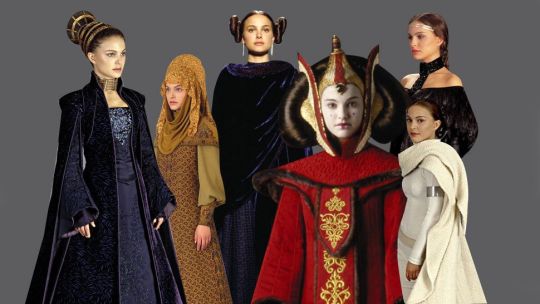
"THE DEMAND FOR AN IDEAL WOMAN"
Recently, the STAR WARS movie, "STAR WARS: EPISODE I - THE PHANTOM MENACE" achieved a milestone. Twenty years has passed since it initial release in theaters in May 1999. However, there have been other recent or upcoming events within the STAR WARS franchise. One of them is the upcoming release of the third Sequel Trilogy movie in December. Another was the recent release of a Young Adults (YA) novel called "Queen's Shadow", the first stand alone story about the Prequel Trilogy's leading lady, Padmé Amidala.
Many fans, especially women, celebrated the release of "Queen's Shadow". Written by EK Johnston, the novel focused on a period in Padmé's life, when her career underwent a transformation from the elected monarch of Naboo to a senator of Naboo. This meant that the novel was set sometime during those ten years between "THE PHANTOM MENACE" and "STAR WARS: EPISODE II - ATTACK OF THE CLONES". More importantly, this novel featured the first time that Padmé was the main protagonist in any STAR WARS movie, television production or novel. "Queen's Shadow" also led many fans to contemplate the idea of Padmé surviving the birth of her twin children, Luke and Leia, and becoming a leader for the early manifestation of the Rebel Alliance. More importantly, the novel and the 20th anniversary of "THE PHANTOM MENACE" has revived the fans' never ending complaint that filmmaker George Lucas should have portrayed Padmé as an ideal character . . . a feminist icon.
As a woman, the idea of a leading woman character as a feminist icon sounds very appealing. But as a lover of films and novels, I tend to harbor a strong wariness toward such characters - regardless of their gender. Recently, some fans have suggested that Padmé should have been the main character of the Prequel Trilogy (1999-2005) and not her husband, Anakin Skywalker. Considering that Anakin eventually became Darth Vader from the Original Trilogy (1977-1983), I found this suggestion a little hard to swallow. Even worse, I find the constant complaints that Lucas had "ruined" Padmé's character, due to the manner of her death in "STAR WARS: EPISODE III - REVENGE OF THE SITH", rather tiresome and pedantic. As I have pointed out in a previous article about Padmé, I found nothing wrong with a person succumbing to death due to a "broken heart" or allowing one's emotions to affect his/her health. Such deaths have actually occurred in real life. And considering that Padmé was in the third trimester of her pregnancy, had endured a series of traumatic events in her professional and personal life, including a recent attack by a jealous Anakin, the circumstances of her death did not surprise me, let alone anger me.
In regard to the idea that Padmé should have been the main protagonist of the Prequel Trilogy Amidala . . . this did not make any sense to me. Like Han Solo and Leia Organa in the Original Trilogy, Padmé was a major supporting character in the Prequel Trilogy. The real focus of the Prequel Trilogy was Anakin Skywalker, which made sense considering he proved to be the catalyst of the Jedi Order's downfall and rise of the Galactic Empire. And in his own way, Padmé and Anakin's son, Luke Skywalker, was the Original Trilogy's main character. Although Ewan McGregor was the leading actor in the second and third films of the Prequel Trilogy, Obi-Wan Kenobi was not the central character. It was still Anakin. And I do not recall any film in STAR WARS franchise being made solely about Obi-Wan. Oh yes, there had been plans for one, but due to the failure of "SOLO: A STAR WARS STORY", Disney Studios had decided to curtail any Obi-Wan solo film. Yet, many did not complain.
Many had bitched and moaned about how Lucas treated Padmé's character, because he had conveyed her weaknesses, as well as her strengths. He did the same with many male characters. Apparently, certain people cannot deal with a major female character's weaknesses being on display, unless she is either the main character or in a drama. What am I saying? Many people still cannot make up their mines on whether they want the Rey character from Disney's Sequel Trilogy to be ideal or flawed. On the other hand, I once came across an article - it might have come from "The Mary Sue Blog" but I am not sure - claimed that the problem with Padmé was not that she was not allowed to have flaws. This person claimed that the that moviegoers saw her as a problem solver who never gave up in the first two movies. The article also added that Padmé was not someone who would give up the will to live. A few years ago, I had written an ARTICLE that discussed Padmé's mistakes in all three Prequel Trilogy movies and argued that she was not the "flawless" or "ideal" character that many still regard her as.
I had also pointed out that in "STAR WARS: EPISODE III – REVENGE OF THE SITH", Padmé had experienced the loss of the Galactic Republic, the rise of the Galactic Empire, the loss of her husband to Palpatine and the Sith, and his physical attack on her in a brief space of time – within two days or less. As someone who had recently experienced personal loss, I understood why she had given in to emotional despair. I had only experienced one loss. Padmé did not. Just because she was able to not give up and overcome a situation in the past, did not mean that she would always be able to do this.
I still recall the "BUFFY THE VAMPIRE SLAYER" Season Five episode called (5.21) "The Weight of the World" in which the main protagonist, Buffy Summers, had went into a catatonic state after she failing to prevent her younger sister Dawn from being abducted by the season’s Big Bad, a hell demon called Glory. Buffy had failed to overcome her state of catatonic depression on her own. She needed help and she eventually got it in the form of one of her closest friends, Willow Rosenberg. There was no Willow to help Padmé deal with her emotional state during the downfall of the Republic and the Jedi Order. Padmé had no Willow to deal with the emotional trauma of Anakin's transformation into a Sith Lord or his attack upon her. Instead, she had to deal with going into premature labor and giving birth to twins. I hate to say this, but neither Obi-Wan Kenobi, Yoda or Bail Organa were as emotionally close to Padmé as Willow Rosenberg was close to Buffy Summers. And instead of providing emotional support to her, the two Jedi Masters and the senator were more focused on her going into labor and giving birth.
There is something about today's feminism that truly irritates me. Women (both in real life and in fiction) are not allowed to be flawed. Actually, I think today's feminists and sexist men have that trait in common. Both groups demand that women be ideal in a way THEY believe women should be ideal. For feminists, women should be some all knowing saint, who can kick ass and have a successful career outside of the home. For sexist men (or men in general), women should be attractive or beautiful bed warmers, home carers and emotional crutches. Women are expected to revolve their lives around the men in their lives. Women in real life are not allowed to be flawed - especially if they are famous. And fictional women - especially those who are major characters in an action story - are definitely NOT ALLOWED to be flawed. Especially someone like Padmé Amidala.
I do not believe that Lucas had subjected Padmé's character with weak writing. I think too many fans were too prejudiced to allow her to be a complex woman with both strengths and weaknesses. They had wanted . . . no, they had demanded she be some feminist icon. While complaining about Padmé's character, they would always compare her with her daughter, Princess Leia Organa aka Skywalker. The ironic thing is that Leia was no more of a feminist icon than her mother. Leia had her own set of flaws. Yes, she was an intelligent and capable political leader, who was also knowledgeable about military tactics and defending herself. Leia also possessed a tough demeanor and a sharp wit. On the other hand, Leia harbored a hot temper, impatience and a penchant for being both judgmental and an emotional coward. Nor was she the type to be forgiving (except with certain people). Two of Leia's flaws - her temper and being judgmental - were on full display in the 1980 movie, "STAR WARS: EPISODE V - THE EMPIRE STRIKES BACK". In that film, she had supported Chewbacca’s angry and murderous attack upon Lando Calrissian, after the latter was forced to betray them to Darth Vader and the Empire. During that scene, both Leia and Chewbacca’s anger got the best of them at a time when it should not have. Neither had pondered over how the Empire had arrived on Bespin before them. Nor did they ever considered that Vader had coerced Lando into choosing between betraying Han and them or watching the Empire destroy Bespin and its citizens.
Many fans have also complained that George Lucas had failed to explore Padmé's backstory . . . especially in "THE PHANTOM MENACE" and "ATTACK OF THE CLONES". I found this complaint rather hypocritical. Lucas had never bothered to explore Leia or her future husband Han Solo's backstory in the Original Trilogy films. Yet, no one or very few people have complained about this. When Disney Studios finally green-lighted a movie about Han's backstory, many film goers and media outlets like "The Mary Sue Blog" bitched and moaned about how it was not necessary. I suspect they had made this complaint, because it was easier than criticizing how Disney Studios/Lucasfilm had handled the movie's production and theatrical release. Is it any wonder that I found this complaint that a movie about Han's backstory was not necessary, but Padmé's was? And to this day, no one has complained about a lack of Leia's backstory in the 1977-1983 films.
Look, I am happy that a novel about Padmé Amidala has been written. And I find it interesting that STAR WARS fans will get a chance to peek into those years between "THE PHANTOM MENACE" and "ATTACK OF THE CLONES". But I must admit that I found myself getting irritated that so many have used the novel's upcoming release to criticize George Lucas' portrayal of her character. It seems obvious to me that a great deal of their criticism is wrapped around a lot of hypocrisy, an inability to understand human nature and a definite lack of attention toward what actually happened to Padmé in the Prequel Trilogy. I cannot help but feel that some people need to realize that in contemplating feminism, they also need to factor in the concept of human nature . . . and good writing. Good writing or a strong character is not one who can do no wrong or be strong, 24/7. A strong character, for me, is someone who possesses both strengths and weaknesses . . . or virtues and flaws. As far as I am concerned, George Lucas had included all in his creation of Padmé Amidala.
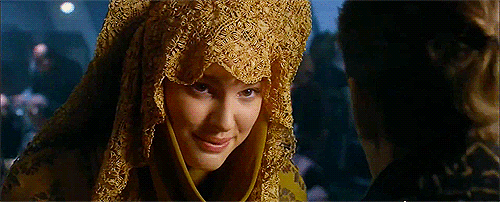
#star wars#star wars saga#star wars prequel trilogy#padme amidala#natalie portman#george lucas#anti the mary sue blog#leia organa#chewbacca#star wars episode i the phantom menace#star wars episode iii revenge of the#star wars episode v: the empire strikes back#carrie fisher#peter mayhew#anakin skywalker
7 notes
·
View notes
Text
The entertainment industry is rife with sexual exploitation and sexual abuse just like the Catholic Church. #TimesUp #MeToo
This is a heartbreaking in- depth article of one of the most prolific directors in recent history.
‘Nobody Is Going to Believe You’
The Bohemian Rhapsody director Bryan Singer has been trailed by accusations of sexual misconduct for 20 years. Here, his alleged victims tell their stories.
By Alex French and Maximillian Potter |March 2019 Issue Culture | Posted January 27, 2019 |
ver the past two decades, Bryan Singer’s films—The Usual Suspects, Valkyrie, Superman Returns, four of the X-Men movies—have earned more than $3 billion at the box office, putting him in the top tier of Hollywood directors. He’s known for taking risks in his storytelling: It was Singer’s idea, for instance, to open the original X-Men movie with a scene at Auschwitz, where a boy uses his superpowers to bend the metal gates that separate him from his parents. Studio executives were skeptical about starting a comic-book movie in a concentration camp, but the film became a blockbuster and launched a hugely profitable franchise for 20th Century Fox.
Singer’s most recent project debuted in November. Critics gave Bohemian Rhapsody—which chronicles the rise of the rock band Queen—only lukewarm reviews, but it earned more than $50 million in its opening weekend. By the end of December, it had brought in more than $700 million, making it one of the year’s biggest hits.
The film’s success should have been a triumph for Singer, proof of his enduring ability to intuit what audiences want. In January it won two Golden Globes, including the award for best drama. But Singer was conspicuously absent from the ceremony—and his name went unmentioned in the acceptance speeches. He had been fired by 20th Century Fox in December 2017, with less than three weeks of filming left. Reports emerged of a production in chaos: Singer was feuding with his cast and crew, and had disappeared from the set for days at a time.
The film’s success should have been a triumph for Singer, proof of his enduring ability to intuit what audiences want. In January it won two Golden Globes, including the award for best drama. But Singer was conspicuously absent from the ceremony—and his name went unmentioned in the acceptance speeches. He had been fired by 20th Century Fox in December 2017, with less than three weeks of filming left. Reports emerged of a production in chaos: Singer was feuding with his cast and crew, and had disappeared from the set for days at a time.
On December 7, 2017, three days after The Hollywood Reporter broke the news of Singer’s firing, a Seattle man named Cesar Sanchez-Guzman filed a lawsuit against the director, alleging that Singer had raped him in 2003, when Sanchez-Guzman was 17. The day after that, Deadline Hollywood published an interview with a former boyfriend of Singer’s, Bret Tyler Skopek, in which Skopek described a lifestyle of drugs and orgies.
According to multiple sources, Fox had no idea that the Sanchez-Guzman lawsuit was coming when the studio fired Singer. Still, Sanchez-Guzman’s claims shouldn’t have been much of a surprise. Almost from the moment his star began to rise, Singer, who is now 53, has been trailed by allegations of sexual misconduct. These allegations were so well known that 4,000 students, faculty members, and alumni at the University of Southern California had signed a petition asking the school to take Singer’s name off one of its programs, the Bryan Singer Division of Cinema and Media Studies—which the school did immediately after Sanchez-Guzman filed his suit. As one prominent actor told us, “After the Harvey Weinstein news came out, everyone thought Bryan Singer would be next.”
We spent 12 months investigating various lawsuits and allegations against Singer. In total, we spoke with more than 50 sources, including four men who have never before told their stories to reporters. A man we’ll call Eric told us that he was 17 in 1997 when he and Singer had sex at a party at the director’s house; another we’ll call Andy says he was only 15 that same year, when he and Singer had sex in a Beverly Hills mansion. Both men say Singer, who was then in his early 30s, knew they were under 18, the age of consent in California. (They asked The Atlantic to conceal their identity for fear of retaliation, and because they didn’t want certain details about their past made public.)
The portrait of Singer that emerges is of a troubled man who surrounded himself with vulnerable teenage boys.
The accusations against Singer cover a spectrum. Some of the alleged victims say they were seduced by the director while underage; others say they were raped. The victims we interviewed told us these experiences left them psychologically damaged, with substance-abuse problems, depression, and PTSD.
The portrait of Singer that emerges is of a troubled man who surrounded himself with vulnerable teenage boys, many of them estranged from their families. Their accounts suggest that Singer didn’t act alone; he was aided by friends and associates who brought him young men. And he was abetted, in a less direct way, by an industry in which a record of producing hits confers immense power: Many of the sources we interviewed insisted, out of fear of damaging their own career, that we withhold their name, even as they expressed dismay at the behavior they’d witnessed.
When asked for comment, Singer’s lawyer, Andrew B. Brettler, noted that Singer has never been arrested for or charged with any crime, and that Singer categorically denies ever having sex with, or a preference for, underage men. (He also disputed specific details in this story, as noted throughout.) Singer himself wrote an Instagram post in October that read, in part:
I have known for some time that [there may be] a negative article about me. They have contacted my friends, colleagues and people I don’t even know. In today’s climate where people’s careers are being harmed by mere accusations, what [these reporters are] attempting to do is a reckless disregard for the truth, making assumptions that are fictional and irresponsible.
Singer continues to enjoy the benefit of the doubt in Hollywood. This fall, Millennium Films signed Singer to direct Red Sonja, an adaptation of a sword-and-sorcery comic book, for a reported $10 million. (Asked why Singer was hired despite the allegations against him, a Millennium publicist said, “I am afraid the response is ‘unavailable for comment.’ ”) The protagonist of Red Sonja is a survivor of sexual assault.
In the spring of 1997, when Victor Valdovinos was in seventh grade, he showed up to school one day to find a big-budget film production under way: All around him were tractor trailers, mobile dressing rooms, and people with walkie-talkies behaving as though they owned the place. The movie was Apt Pupil, Singer’s first project after his breakthrough, The Usual Suspects.
Filming took over Eliot Middle School in Altadena, northeast of Los Angeles. Late one afternoon, after basketball practice, Valdovinos stopped in an empty restroom. While standing at a urinal, he says, he felt a presence behind him. He turned and saw a bespectacled man in his early 30s. It was Bryan Singer. He looked Valdovinos over; Valdovinos remembers him saying, “You’re so good-looking. What are you doing tomorrow? Maybe I could have somebody contact you about putting you in this movie.” (Through his attorney, Singer said that he did not know who Valdovinos was and denied that anything had happened between them.)
The film, which was based on a Stephen King novella, starred Ian McKellen as Kurt Dussander, a former Nazi concentration-camp commandant living in Southern California, decades removed from the war and trying to keep his past a secret. The other lead was a 14-year-old named Brad Renfro—cast as Todd Bowden, Dussander’s neighbor, who discovers the Nazi’s secret and threatens to turn him over to authorities unless the old man tells him in graphic detail about the atrocities he committed. One scene has Todd taking a shower in his school’s gym, which triggers images of Jews in a gas chamber.
That scene would lead to a series of lawsuits against Singer and the production. At least five plaintiffs, all minors between the ages of 14 and 17, were extras in the film and, in essence, claimed that members of the crew had bullied them into stripping naked for the shower scene. The boys and some of their parents said they’d been aware that the job called for partial nudity, which they had been led to believe meant wearing a Speedo or a towel. One of the crew members later said he thought that there had been a screwup the day of the shoot—that only the adult extras were supposed to have been asked to appear naked, and that somehow the minor and adult extras had been mixed together. The Los Angeles County District Attorney’s Office declined to press any criminal charges; the suits—which alleged negligence, unlawful sexual harassment, invasion of privacy, and intentional infliction of emotional distress—were settled for an undisclosed sum, and all parties were bound by confidentiality agreements.
As he watched the Harvey Weinstein scandal unfold, Valdovinos thought, “Me too— only I was a kid.”
By Valdovinos’s account, his experience on the Apt Pupil set was far more upsetting. After being dropped off by his father one morning, he was directed to the locker room. Shooting was about to begin. He remembers that the locker room had been divided—a screen here and lights over there. A crew member gave him a towel and told him to disrobe completely and wrap the towel around his waist. He was 13 years old. He hadn’t yet had his first kiss.
“I’m hanging out,” Valdovinos says. “All of a sudden, Bryan comes in. He goes, ‘Hey! How are you?’ Real cheerful. And I’m like, ‘Hi.’ I can’t remember his exact words, but he was kind of just saying ‘Come back here.’ He kind of directs me; he kind of grabs me; and he takes us to the back area, which was kind of closed off. Like, this is the whole locker room”—Valdovinos gestures to suggest the space—“they’re doing their stuff over there, and I was back here, in the towel, with no shirt and no clothes on, sitting on one of the locker-room benches. Bryan’s like, ‘Just hang out here. It’s going to be all day. Don’t worry.” Singer left, and Valdovinos waited for what seemed like hours.
Eventually, he says, Singer came back and made small talk. How are you doing? Do you need anything? “Every time he had a chance—three times—he would go back there … He was always touching my chest.” Finally, according to Valdovinos, Singer reached through the towel flaps and “grabbed my genitals and started masturbating it.” The director also “rubbed his front part on me,” Valdovinos alleges. “He did it all with this smile.” Valdovinos says that Singer told him, “You’re so good-looking … I really want to work with you … I have a nice Ferrari … I’m going to take care of you.”
“I was frozen. Speechless,” Valdovinos continues. “He came back to where I was in the locker room throughout the day to molest me.” (Three sources confirmed that Singer did drive a Ferrari at the time, and we were able to verify Valdovinos’s description of how the set was arranged and of certain people he says he met there. His father told us he remembers dropping him off for the filming and thinking that perhaps his son would become an actor. Singer’s lawyer said that he could find no record of Valdovinos’s having been an extra and questioned why Valdovinos was not able to produce a pay stub or other documentation.)
CONTINUED ON WEBSITE
2 notes
·
View notes
Text
The Weekend Warrior 8/13/21 - CODA, FREE GUY, DON’T BREATHE 2, RESPECT, THE LOST LEONARDO, WHAT IF, and More!
Well, that was kind of a disappointing last weekend as James Gunn’s The Suicide Squad pretty much tanked at the box office, making less than Birds of Prey did back in February 2020 with all sorts of backseat analysis explaining why it didn’t do well as anyone, other than a scant, few thought. I mean, I’m still kind of stunned, even though COVID and the Delta variant seem to be losing steam as far as being news. It certainly didn’t help that HBO Max decided to release the movie concurrently on HBO Max on Thursday at 7pm.
The nice thing about this week is that we have three new movies, none of which are on streaming or On Demand at the exact same time, so if you want to see any of them, you’ll have to put on your N96 masks and get yourself to theaters. Two of the three movies are originals, while the third is a sequel to quite an original horror movie from about five years back. All of them are pretty good, actually. We’ll get to them soon...

But first, let’s start with this week’s “The Chosen One” and it’s gotta be Siân Heder’s CODA i.e. “Child of Deaf Adults,” which will play in select theaters and on Apple TV+ starting Friday. If you hadn’t heard, it was the belle of the ball at this year’s Sundance Film Festival, winning the Jury Prize and Audience Award alike. Heder previously directed Tallulah and is the showrunner on Apple’s Little America, but this really is a very special film that I’ve enjoyed on repeat viewings now.
It stars Emilia Jones as Ruby Rossi, the sole hearing person in her family of Gloucester fishermen, who are out every day on the sea making the latest catch in their nets. Ruby has other aspirations, and when she joins the school choir, the teacher, Mr. Villalobos (Eugene Derbez) sees talent in Ruby that he thinks might get her into the Berklee College of Music. Ruby has to weigh that with her family’s need to have her as an interpreter while dealing with the other fishermen of the town.
I didn’t know what to expect when I saw this at Sundance back in January, and it still surprised me when I rewatched it again, because it’s a movie that involves a lot of elements that shouldn’t necessarily work, between the fishing and the singing and all the ASL between the amazing ingenue, Ms. Jones, and the deaf actors playing her family, including the one and only Oscar-winning Marlee Matlin. If not for these disparate elements, Coda might be a fairly standard indie family drama, but Heder finds just the right balance of showing how these disparities in Ruby’s life make it hard for her to pursue her dreams.
Ferdia Walsh-Peelo from Sing Street plays the classmate who Ruby is set up with to perform a duet at their high school recital, and of course, he also becomes an unwitting love interest. Unfortunately that’s the aspect of the film that’s the weakest, because Jones’ scenes with Matlin and the other actors, including Derbez, as well as Troy Kotsur and Daniel Durant, as Ruby’s father and brother, are just so powerful and moving even if they’re all in ASL with no dialogue or even incidental score.
Coda is Heder’s second film after Talllulah, a movie starring Elliot Page that never really connected with me, but Coda is such a strong and exceedingly crowd-pleasing film that I have to imagine that this would connect with everybody. I’m not sure if Apple’s gonna be able to get this movie all the way to Oscar night, but I do like its chances for Adapted (?) Screenplay, and maybe Matlin and Kotsur Supporting? I don’t know, because it’s so early and hard to tell, but hopefully the decision to wait so long after the virtual Sundance won’t hurt this movie as it hurt other Sundance award-winning films. Coda is just a joy that I’m sure will be many people’s favorite movie.
You can read my interview with Ms. Heder over at Below the Line.
Incidentally, in last week’s column, I talked about the 20th New York Asian Film Festival, but I didn’t realize that it was only running at Film at Lincoln Center for a week before going down to the SVA Theater on 23rd Street, and you can check out the schedule of movies playing there at the official site. And of course, there’s still the Virtual Festival that’s running through August 22. Also, Fantasia is still going on in Montreal, and I still haven’t had time to watch very much. What can I say? I suck.
Let’s get to some wide releases, shall we?
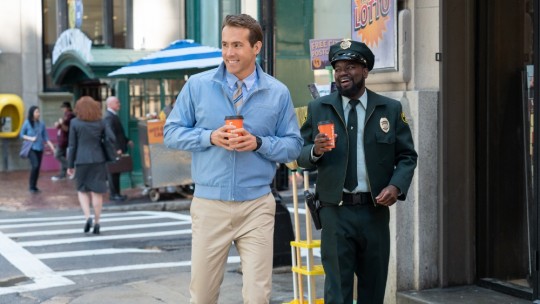
First up and probably the most likely to win the weekend is Ryan Reynolds’ new action-comedy, FREE GUY (20th Century Studios), directed by Shawn Levy and co-starring Jodie Comer from Killing Eve. The high-concept comedy has Reynolds playing Guy, a bank teller, who actually is a non-player character in a video game called “Free City” that’s kind of a cross between Grand Theft Auto and Fortnite. When he meets Comer’s character in the game, he falls mady in love and decides to do whatever it takes to get on her level. (Get it?) In doing so, Guy ends up becoming a hero for Free City, as well as a viral sensation across the globe as gamers thrill to Guy’s adventures.
Free Guy is Ryan Reynolds’ first live-action starring role theatrical release since…. Oh…. the action-comedy sequel The Hitman’s Bodyguard’s Wife a little under two months ago. Considering that barely made half of what its predecessor did, and that’s with Reynolds sharing the screen with Samuel L. Jackson and Salma Hayek, one wonders if his draw as an A-lister can be maintained during a pandemic. Before that, you’d have to go all the way back to 2018’s Deadpool 2 for a fully live Reynolds movie, because he wasn’t seen as himself for most of his role in and as Detective Pikachu. Of course, Reynolds’ unmistakable voice was back in DreamWorks Animation’s The Croods: A New Age, the sequel to the 2013 blockbuster that made the ballsy move to be one of the first movies to open during the pandemic. It grossed $58.6 million in theaters, which was slightly more than Christopher Nolan’s Tenet and even more than the Warner Bros. sequel, Wonder Woman 1984.
This is also a big movie for Jodie Comer, who won an Emmy and was nominated for two Golden Globes for Killing Eve, but hasn’t really been in too many movies, other than playing Rey’s Mum in Star Wars: The Rise of Skywalker. Later this year, she’ll star in Ridley Scott’s The Last Duel and may possibly be back in the awards game again, we’ll see. The movie also stars Lil Rel Howery, who seems to be everywhere and in everything these days, as well as Taika Waititi who is super-hot right now due to 2019’s Jojo Rabbit, and his various television projects, as well as having a small role in James Gunn’s The Suicide Squad last week.
In some ways, Free Guy is gonna be a test for a lot of things, the first one being whether Reynolds is a big enough draw when not playing Deadpool to get people into theaters, just as people are starting to get skittish again about going into movie theaters. More importantly, it will show whether not having a movie on streaming or VOD means that people who want to see it will put aside their fears and return to theaters… like they did with F9 and Black Widow and Godzilla vs. Kong. Is an original non-franchise movie like Free Guy enough to get people interested in getting their butts off the couch and into a far more comfortable movie theater seat? (I’m being facetious, if you didn’t guess.)
After The Suicide Squad last week, I’m really not sure whether I can trust my own instincts, but I also don’t want to lower my prediction to something ridiculous out of fear that the pandemic really is destroying any chance of the box office fully recovering. One thing working in Free Guy’s favor, besides its PG-13 rating is that it’s not available on streaming and VOD. Anyone who has been intrigued by the film’s great reviews will HAVE to go out to a movie theater to see it or else, they’ll have to wait 45 days.
Maybe if this opened last month, I could see it open in the $30 million to $40 million range, but with things being the way they are, I’d probably go with high $20 million, so close to $30 million but not quite.
You can read my review over at Below the Line, and I’ll have an interview with the film’s Production Designer, Ethan Tobman, fairly soon.

Also opening Friday is the horror sequel DON’T BREATHE 2 (Sony/Screen Gems), starring Stephen Lang as the blind former Navy Seal who terrorized a bunch of kids who broke into his house in 2016’s Don’t Breathe.
The original movie, which starred Jane Levy, reuniting with director Fede Alvarez after the two remade Evil Dead for producer Sam Raimi, opened in late August, on the fourth weekend of the original Suicide Squad, in fact, and it knocked the movie out of the #1 spot. Its $26 million opening in 3,000 theaters was impressive for the time, partially because late August has never been great. It stayed #1 for a second weekend, over Labor Day, and it ended up grossing $89.2 million in North America, which is great for an R-rated horror film.
Levy isn’t around for the sequel and Alvarez has moved into a co-writer/producer role for his creative partner, Rodo Sagayes, to take over the directing reins, but honestly, I’m not sure how many people will know or care, because Lang’s character and the film’s violence and chills are it’s real selling point. Like many horror movies, there isn’t much in terms of star power other than Lang, but that has never really hindered the success of a horror movie in the past.
As with every movie I cover in this column, there’s the pandemic in the room and whether that might hold people back from going to theaters. I wish there was a way to calculate the effect that’s had on moviegoing, because it seems to affect movies differently. For instance, the recent The Conjuring: The Devil Made Me Do It was able to open with $24.1 million just two months ago, although that was down from the $40 million of the previous two chapters. So that’s about a 40% drop-off in a similar five-year gap between movies. (Actually, it’s kind of strange that 2021 is replicating 2021 with three sequels to movies from five years earlier.) There’s no denying that the number of Covid cases are way up since June and movie theaters are still being painted as the “enemy” even though no significant cases have been traced back to the movies.
We also have to look at Sony’s last horror sequel, Escape Room: Tournament of Champions, which I quite enjoyed, but it ended up opening with about $10 million less than the original movie a few years back. We can probably expect Don’t Breathe 2 to have a similar pandemic drop-off even if it’s another movie that won’t be on streaming or VOD this weekend.
I think Don’t Breathe 2 should be good for around $15 million this weekend since it’s catering towards a young audience that’s a bit more devil-may-care about going out to theaters. It will also probably appeal more to older single guys than something like Free Guy, which seems different enough to pull in a different audience.
My review will be posted over at Below the Line later on Thursday, plus I have a bunch of interviews coming, including this one with Rodo Sayagues and Fede Alvarez.
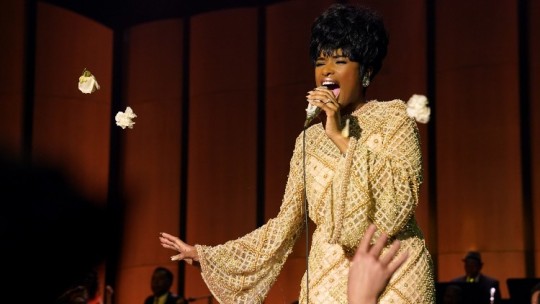
Next up is RESPECT (MGM), the long-awaited Aretha Franklin biopic (for those that didn’t see Genius, like me, I guess), starring Oscar-winner Jennifer Hudson as the Queen of Soul. The movie directed by Liesl Tommmy was supposed to be released in January to take part in last year’s Oscars race, but I guess MGM wanted to make sure it got a proper theatrical release, which wasn’t possible since NYC and L.A. movie theaters didn’t reopen until March after the cut-off. But MGM had already decided to push the movie back to the summer in hopes of having more theaters able to play the movie, which is kind of true now?
It’s been a while since we’ve seen JHud in a high-profile theatrical release, and unfortunately, the last one was 2019’s Cats, a movie in which she probably was the best thing, although it still only grossed $27 million domestically, a flat-out bomb. Before that, she provided her voice for the animated blockbuster Sing in 2016, and then a bunch of smaller movies before that. She’s joined in the movie by the likes of Oscar winner Forest Whitaker, Marlon Wayans, Titus Burgess, Mary J. Blige, Marc Maron, and Audra MacDonald, quite an impressive array of talent that shows how many wanted to be involved with this project. Director Liesl Tommy is making her feature directorial debut after directing a ton of theater and TV shows like The Walking Dead and Jessica Jones.
Even so, it’s obviously that the ongoing popularity of Aretha Franklin, especially since her death in 2018, is going to go a long way into getting people into theaters, which includes a lot of older black women who really haven’t had much to get them out into theaters in recent months. Will this be enough?
Before Respect was delayed from its original January release, many thought that Hudson would receive another Oscar nomination for her performances. Having not seen the movie at the time of this writing, I can’t confirm or deny those chances. If that’s still the case, then releasing the movie towards the end of the summer (similar to The Help, successfully, and The Butler, not so much) is an odd decision rather than just holding the movie for festival season by holding until next month.
Either way, I think the love Aretha’s fans have for the Queen of Soul as well as Hudson’s fans, Respect should be good for between $8 and 10 million this weekend -- hard to pinpoint exactly without knowing how many theaters MGM is getting for it against the stronger summer movies.

Mini-Review: I wasn’t really sure what to expect from Respect, even after seeing the trailer a couple dozen times in front of other movies, but it’s a respectable biopic that cover 20 years in the life of the Queen of Soul from singing at a young age in her father’s church to returning to church for the gospel records as captured in the recently-released doc, Amazing Grace.
But first, we go back to 1952 where Aretha is a young girl (played by Skye Dakota Turner) is uncertain of her future as she’s being ordered about by her preacher father (Forrest Whitaker) and trying to find direction. The movie casually sets up the fact that young Aretha was sexually abused by a family friend, and maybe she got pregnant, too? It’s hard to tell and maybe a little odd since she would only have been 10 at the time, but it’s something that will be brought up (just as subtly) over the course of the film.
Jennifer Hudson takes over as Aretha as she turns 19 and goes to New York City to start recording, meets Marlon Wayans’ Ted White, makes him her manager and marries her, which basically has her going from one abusive man in her father to another one. It feels like the movie spends a long than normal time on the ‘60s, which is when Franklin’s career really took off with “Respect” and then a series of hits that took her all around the world. That whole time, she’s dealing with Ted’s abuses and jealousy while trying to write and record those hits, before her dark demons return and she starts drinking heavily.
As you might imagine, you go to see Respect to see how well Jennifer Hudson pulls off the Queen of Soul, and she’s an incredibly complex character that needs a nuanced performance, which Hudson tries to pull off by bringing different aspects of her life into different scenes.
There are some scenes that don’t work as well as others, and it feels like there’s a bit of time-crunching or futzing around so that at a certain point, her father seems to be de-aging, although I was just as impressed (possibly even moreso) with Forrest Whitaker, whose performance as Aretha’s father is more than just a full-on villain despite his violent treatment of his daughter. Wayans is also good and almost unrecognizable at first, and there are a few other nice performances in there as well, including Marc Maron as record label head Jerry Wexler.
But the performances Hudson gives as Franklin are goosebump-inducing, leading up to the recording of her record-selling gospel record as depicted in the aforementioned doc.
A fairly decent representation of Franklin’s little-known life leading up to her fame, Respect probably succeeds the most when Jennifer Hudson is performing as the Queen of Soul, but she’s also created a fairly moving portrait with strong dramatic moments that far outweigh any of the film’s issues. Rating: 8/10
With that in mind, this is how I see the weekend looking with two of the new movies bumping Suicide Squad down to third place where it will be facing off against Respect.
1. Free Guy (20th Century/Disney) - $28.5 million N/A
2. Don’t Breathe 2 (Sony/Screen Gems) - $15 million N/A
3. The Suicide Squad (Warner Bros.) - $10 million -62%
4. Respect (MGM) - $9.6 million N/A
5. Jungle Cruise (Walt Disney Pictures) - $8.7 million -55%
6. Old (Universal) - $2.5 million -36%
7. Black Widow (Marvel/Disney) - $2.4 million -39%
8. Stillwater (Focus) - $2 million -39%
9. Space Jam: A New Legacy (Warner Bros.) - $1.3 million -43%
10. The Green Knight (A24) - $1.1 million -56%
Donnie Yen stars in Bennie Chang’s RAGING FIRE (WELL GO USA), which premiered at the New York Asian Film Festival on Monday and at Fantasia in Montreal on Tuesday, and I’m not going to review this, because honestly, it’s such a cookie-cutter Hong Kong police action-thriller that I’m not sure I really have much to say about it, so I won’t.
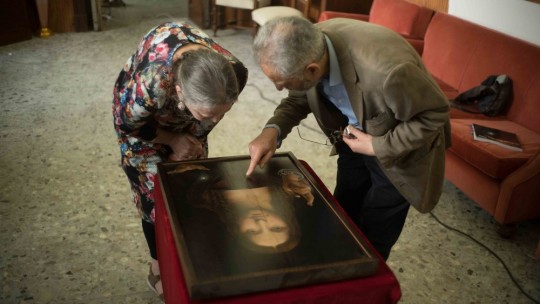
On the other hand, I do have more to say about Andreas Koefoed’s documentary, THE LOST LEONARDO (Sony Pictures Classics), the Leonardo being Da Vinci, the master artist behind the Mona Lisa and many other works. Since I don’t really follow the world of art, I really didn’t know about the Salvator Mundi painting found about 10-12 years ago that was thought to be an original Da Vinci worth in the hundreds of millions, often dubbed “The Male Mona Lisa.” But it’s also a painting that was surrounded by controversy due to the 5-year restoring job that may have left very little of the original painting.
As the film began, I was groaning a little about sitting through another movie of art experts and historians talking about how important a find this is and why it’s either great or horrible, depending on who is being interviewed. Eventually, the film gets more interesting as it starts getting into the idea of selling it. After being sold to a wealthy Russian oligarch by an unscrupulous Swiss art dealer who made a nice profit on it, the painting ends up being auctioned by Christie’s, and the story just keeps getting more and more interesting as it goes along.
While I’m not one to go ga-ga over any painting by Da Vinci or otherwise, I do like a good mystery or suspense-thriller, so good on Koefoed for realizing about halfway through this movie that the talking heads will never be as interesting as actual footage. And that’s what happens here, too. I actually feel a little ignorant that I wasn’t aware this was going on as it was, maybe because I don’t really follow the art world in that respect. Maybe I just missed it, so it’s good that Sony Classics (who loves making movies about art) is giving this a fairly high-profile release following its premiere at the Tribeca Film Festival a few months back. In that sense, The Lost Leonardo is quite a gem.
Heinz Brinkman’s USEDOM: A CLEAR VIEW OF THE SEA (Big World Pictures) is a somewhat intriguing doc about the Baltic island of Usedom, the location of a number of imperial German health resorts, beaches and such, and how the Jews were kicked out by the Nazis before Usedom was split into a German and Polish half after WWII. I wish I could get into this more, but I just have a limited mental capacity for a lot of German talking heads.
Which brings us to Michael Tucker and Petra Epperlein’s THE MEANING OF HITLER (IFC Films), the new doc from the team behind Gunner Palace, which looks at the cultural fascination with Hitler and Nazism and the recent rise in white supremacy, antisemitism and the “weaponization of history itself.” I don’t know what that last part means, because I got so swamped this week that I didn’t get to watch this, and like another recent doc on the subject of Naziism and the Holocaust, I just couldn’t get into the right head space to hit play on this doc. Maybe I’ll watch it sometime down the road.
Similarly, I didn’t get around to watching Dutch filmmaker Jim Taihuttu’s THE EAST (Magnet Releasing), which I may like as a fan of Paul Verhoeven’s Dutch WWII films, and I probably should give this a look, but I just ran out of time this week. It’s about a young Dutch soldier who joins an elite unit led by a mysterious captain called “The Turk,” and it takes place in the Indonesian War of Independence after World War II.
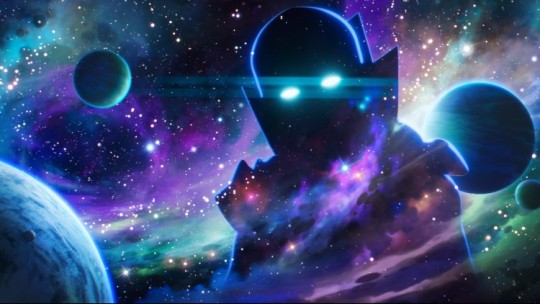
As far as TV goes, Wednesday sees the debut of Marvel Studios’ WHAT IF...? on Disney+. I’ve seen the first three episodes, and I was a pretty big fan of the comics in the ‘70s (sadly, part of the giant collection that I sold a few years back), and I guess this is okay. The first episode is the one with Haley Atwell voicing “Captain Carter” i.e. Peggy Carter gets the Super Soldier Serum, which is one of the more obvious What Ifs that could possibly done, so that we can get another “women are as good as men, and they need to be heard” storyline that’s in 90% of the Marvel movies already. On the other hand, the first episode does include the voices of Sebastian Stan and others, so it’s quite a coup in that sense, but whoever wrote it, clearly doesn’t understand that people spoke differently in the ‘40s. I liked the 2nd episode, a mash-up of Black Panther and Guardians of the Galaxy, which is a fun idea that brings together a lot of great characters -- including Chadwick Boseman’s last voice performance -- but again, hearing the voices just isn’t the same when the writing isn’t as good as the movie. I feel like the animation for the show is okay, maybe not quite on par with some of the great Batman or Superman cartoons we’ve gotten over the years. On the other hand, the entire series features the great voice of Jeffrey Wright as The Watcher, acting kind of like the Rod Serling for the series, much like the Watcher does in the comics. I also dug the music by Emmy winner Laura Karpman (Lovecraft Country), and I’ll watch the rest of the series as it debuts, but I’m not sure it’s as much a rush to see each episode to avoid spoilers as with Loki or WandaVision.
Hitting Netflix this week is the limited series, BRAND NEW CHERRY FLAVOR (Netflix), starring Rosa Salazar, Eric Lange, and Catherine Keener. The tagline is: “Lisa Nova (Rosa Salazar) comes to LA dead set on directing her first movie. But when she trusts the wrong person and gets stabbed in the back, everything goes sideways and a dream project turns into a nightmare. This particular nightmare has zombies, hit men, supernatural kittens, and a mysterious tattoo artist who likes to put curses on people. And Lisa’s going to have to figure out some secrets from her own past in order to get out alive.”
Also, TITANS Season 3 debuts on HBO Max, but since I haven’t watched seasons 1 or 2 yet, it might be some time before I get to it.
Next week looks like it could be a bit of a dog with four or five new wide releases but nothing that really jumps out, plus I’ll be in Atlantic City all next weekend, so who knows how much I’ll be able to watch or write about?
#The Weekend WArrior#Movies#Reviews#Coda#Free Guy#Respect#Don't Breathe 2#the Lost Leonardo#Box Office
0 notes
Text
Looking Back at the Legacy of 'The Great White Hope' and Boxer Jack Johnson
https://sciencespies.com/history/looking-back-at-the-legacy-of-the-great-white-hope-and-boxer-jack-johnson/
Looking Back at the Legacy of 'The Great White Hope' and Boxer Jack Johnson

SMITHSONIANMAG.COM |
Feb. 25, 2021, 8 a.m.
“There’s nothing you need to make up about Jack Johnson.”
Documentarian Ken Burns would know. His 2005 series “Unforgivable Blackness,” based on the book of the same name by historian Geoffrey C. Ward, brought the true story of the life and career of Jack Johnson, the black boxer who fought his way up through the pugilism ranks to become the world heavyweight champion, to television.
But before Burns, those who weren’t around for the so-called “Fight of the Century” that saw Johnson outslug James J. Jeffries in 1910, would have known Jackson’s story through the play and movie The Great White Hope. That work of historical fiction, by playwright Howard Sackler, perhaps reveals more about the time in which it was written than the time in which it is set.
The play’s message about the nature of racism and racial conflict succeeded in providing audiences with an opportunity to better understand different perspectives through the prism of its characters, but the film adaptation failed to deliver the same powerhouse impact. That said, both served to launch the careers of two actors on the rise and brought to the public a poignant story of interracial romance and the struggle for interracial couples to find acceptance in America.

Alexander and Jones in a publicity still from the 1970 film
(Photo by Afro American Newspapers / Gado / Getty Images)
Sackler’s much-lauded play arrived in 1967, as the civil rights movement’s struggles were at last bearing fruit. In The Great White Hope, black boxer Jack Jefferson—a name change borne out of legal concerns—becomes so successful that a fight is set up between Jefferson and the reigning heavyweight champion of the world, a white man. In addition to developing a story which focused on an equivalent of the Johnson-Jeffries fight, Sackler constructed a storyline based on the relationship between Johnson and his first wife, a white woman named, Etta Terry Duryea, represented in the play by the character of Eleanor Bachman. In addition to mirroring the tensions Johnson and Duryea endured in pursuing an interracial relationship during the early 20th century, Eleanor’s ultimate fate mirrors that of Duryea, who died by suicide in 1912.
The play’s title came from the descriptor assigned decades earlier to any white boxer who stepped into the ring to challenge Johnson, although it was most famously used to describe Jeffries, who had retired from the ring more than five years before the landmark fight. Upon being wooed into returning to the ring, Jeffries made his reasons perfectly clear, publicly announcing, “I am going into this fight for the sole purpose of proving that a white man is better than a Negro.”
As history reveals, Jeffries proved no such thing: not only did Johnson win the fight by a technical knockout in round 15, but as fellow boxer John L. Sullivan told the New York Times, “Scarcely has there ever been a championship contest that was so one-sided.”
youtube
Sackler drew inspiration from these events, seeing in Johnson an opportunity to tell a story about a man who becomes a hero but is nonetheless destined for a downfall, someone who many—including the play’s director, Ed Sherin—likened to the titular character in William Shakespeare’s Coriolanus. “It’s about a man who essentially moves out of his tribe and gets clobbered,” Sherin told The American Theatre in 2000. “And in [Sackler’s] mind, it wasn’t about black-white. The historical circumstances made that the paramount issue in the play. But it’s not. And it taps off white guilt about the way the black man was dealt with, but that was not [Sackkler’s] position at all. He wrote a play about a tragic hero, somebody who oversteps himself—as Coriolanus did.”
***********
The Great White Hope began with a grant from the National Endowment for the Arts to Arena Stage, a Washington, D.C. theater, which at the time was best known for being the first integrated theater in the city. To find the right man for Jefferson, Sackler reached out to actor James Earl Jones, an established performer was working in Europe.
“Howard suggested that I start getting into shape, which was really important—the man was a boxer—but which I was not and am not and will never be!” says Jones, laughing. “In fact, the young man who was my understudy onstage, Yaphet Kotto, resembled Jack much more than I did.”

James Earl Jones looks at his reflection in a Broadway dressing room mirror on December 10, 1968.
(Photo by Harry Benson / Daily Express / Getty Images)
For the role of Bachman, Sherin went with an existing member of the Arena Stage company: actress Jane Alexander, who would later become Sherin’s wife. Despite the racially charged subject matter, Alexander had no hesitation about diving headlong into the material.
“I really looked forward to doing things like that,” says Alexander. “Of course, civil rights were very high at that time in the ’60s, and we did not shy away from controversy at Arena Stage. We did quite a lot of things, tackling the Vietnam War and racism and so on, so I didn’t have any problem with the subject matter.”
Alexander also politely disagrees with her co-star’s self-assessment. “[James] is a big man—he certainly looks like a heavyweight champion!—and he got in such great shape,” she says. “He was just gorgeous-looking at the time. But he was formidable…and when he gets that look in his eyes, he’s scary!“
The Great White Hope only played for a few weeks at Arena before its success catapulted it to Broadway. Although the audiences were initially almost entirely white, Alexander says that the number of black theatergoers began to increase steadily as the play received more acclaim, hitting the 50/50 mark by the end of the first year. As a result, she also began to notice that black audiences reacted differently to the play than white audiences.
“They didn’t like my character at all…and who could blame them?” concedes Alexander. “I was causing him all these problems! So they would sometimes cheer or laugh at my death…and that was not easy for James Earl, because [he] looked at it as a love story. He had a very difficult scene to perform over my dead body, and they were sometimes not happy with him being emotional about me.”
Even worse, Alexander also began receiving hate mail. “Sometimes they were just disgusting letters from white bigots, male and female. Really awful letters. But I got a couple of death threats. That’s when I said to my stage manager, ‘I can’t open my mail.’”
Jones, for the record, didn’t receive any such threats, but the fact that his co-star did receive them, he says, “sort of measured the height of the bull****.”
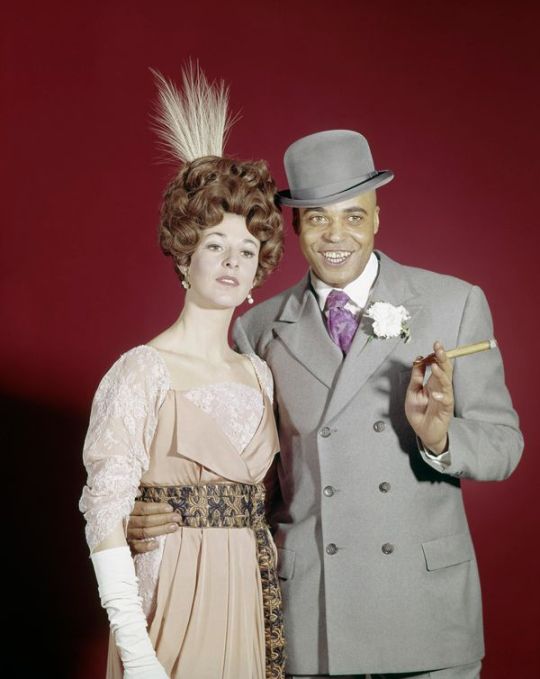
Both Alexander and Jones received Tony Awards for their work in The Great White Hope.
(Photo by NBCU Photo Bank / NBC Universal via Getty Images)

Muhammad Ali at a November 12, 1968, performance of The Great White Hope on Broadway
(Photo by Tom Wargacki / WireImage)
Fortunately, those who appreciated The Great White Hope far outweighed those who didn’t, and one of the play’s biggest fans was one of the most famous men in the world: Muhammad Ali, who understandably saw some parallels between himself and Jones’s character. (“What Ali actually said was, ‘This is my play, except for the white chick,’” recalls Alexander, laughing.)
“Muhammad Ali had just done a Broadway play himself—or, rather, a musical—called Buck White, where he played kind of an activist,” recalls Jones. “He considered himself a stage actor, I think, so he’d come back and wanted to talk actor to actor about my work. When the audience left the theater, he used to love going up on the stage and say, ‘Watch this!’ And he’d take a crack at a scene, and then he’d say, ‘And that’s the way that ought to be done!’ I loved it. And the way he’d interpret it? He wasn’t always wrong!”
Ali was also responsible for one of Alexander’s most cherished memories from the Broadway run of The Great White Hope, during the third of his backstage visits.
While the film version of The Great White Hope received its fair share of critical acclaim, with both Jones and Alexander—in her film debut—earning Oscar nominations for their work, few would disagree that it’s a lesser work than the play. The first sign that Hollywood had done some major streamlining: the play originally ran for three-and-a-half hours, whereas the film version clocks in at a streamlined 103 minutes.
“I missed some of the lyricism in the beautiful long monologues—or soliloquies, if you will—that some of the actors had, specifically [James],” says Alexander. “They were cut, a lot of them. “
Jones pulls no punches when offering his take on the play’s cinematic adaptation. “I apologize for the film, because it wasn’t right,” he says. “The big mistake happened when the decision was made not to have Ed Sherin direct the film. It was a big investment on the part of 20th Century Fox, and they made an attempt to work around the cost of filmmaking. They decided to make it… I wouldn’t say ‘cheap,’ but they thought they couldn’t afford to take a gamble on [a first-time film director].”
“They made a decision to shorten it by using a formula which… Well, I won’t try to define it, but they wanted to make it a romance,” says Jones. “Which it was in real life, but it was a mistake to try and ignore all the dynamic stuff going on in that man’s life in favor of trying to make it a love story of this poor black guy and this poor white girl who wanted to be together in life. But America just didn’t let them do it.”
Jones’s description of the film’s romantic plotline is dripping with sardonic wit, something which becomes evident when he abruptly begins chuckling.
“The truth is, I think Ken Burns’ documentary is more important than the film or the play we did,” says Jones. “I thought there was no way you could capture all the dynamics of that man’s life, all the gorgeousness and physical beauty, the human beauty of the man called Jack Johnson. But Burns captured it. Whether you’re a boxing fan or not, whether you have any corner of the race issue you want to explore, it’s something everybody should see.”
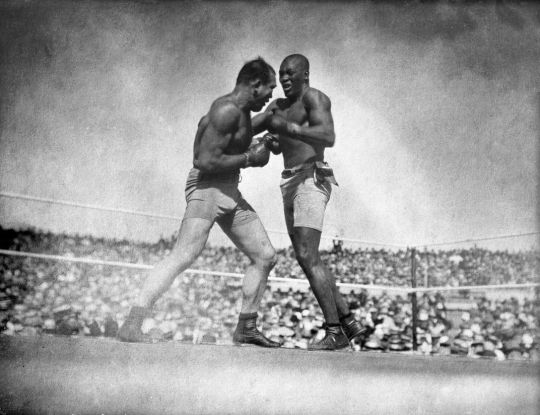
Jack Johnson (right) defeated Jim Jeffries in a 1910 boxing showdown.
(Photo by PA Images via Getty Images)
“He stuck around late enough that the stage manager had already put the ghost light onstage. Only the doorman was left, and I was in the wings. And Muhammad Ali walked out in that dark theater and turned to a naked, empty house, and he reprised the last line of the second act: ‘I is here! I is here! I is here!’ It was amazing. And nobody ever witnessed that but me. “
**********
The success of The Great White Hope soon led to conversations about adapting the play into a film, but those conversations didn’t include Alexander until after the show swept the Tony Awards, winning Best Play and earning Jones and Alexander trophies for their roles, too. The acclaim even extended beyond the traditional theater community, with the play winning the Pulitzer Prize for Drama as well.
“I was told that [film director] Martin Ritt offered it first to Joanne Woodward,” says Alexander. “She turned it down, saying, ‘You should get that girl who did it on Broadway.’ And then he went to Faye Dunaway, and Faye turned it down! And then what happened after Faye turned it down? The Tony Awards happened. And the next day, I got the offer.”
youtube
Burns, who interviewed Jones for “Unforgivable Blackness,” believes the problem with the film adaptation extends well beyond trying to force it into being a love story.
“The much more important thing is something that you find throughout well-intentioned history and art about African-Americans, which is that somehow they always need to have a white person around to justify them,” says Burns. “In The Great White Hope, here’s this incredibly talented physical specimen who plays in all these incredibly dangerous tropes about black people, and yet somehow you need well-intentioned white handlers in whatever form—romantically or fight-wise—to sort of nudge you to the right direction, as if they’re unaccompanied minors who need to be accompanied.
Adds Burns about the real story he found while making the documentary, “What’s so important about Jack Johnson is that he defies all conventions we want a heroic black man to be in. He doesn’t want the job of hero. Somehow we want our African Americans to conform to some version of our idea of an acceptable black person. Jack Johnson just takes dynamite and pushes the plunger on that.”
“I admire the play, and I admire the movie, and it’s heart is in the right place, and it’s intentions are good, but it’s in a narrow bandwidth that doesn’t permit the full scope of Jack Johnson, good, bad, and otherwise,” concludes Burns. “It constrains him with narrative devices that aren’t needed.”
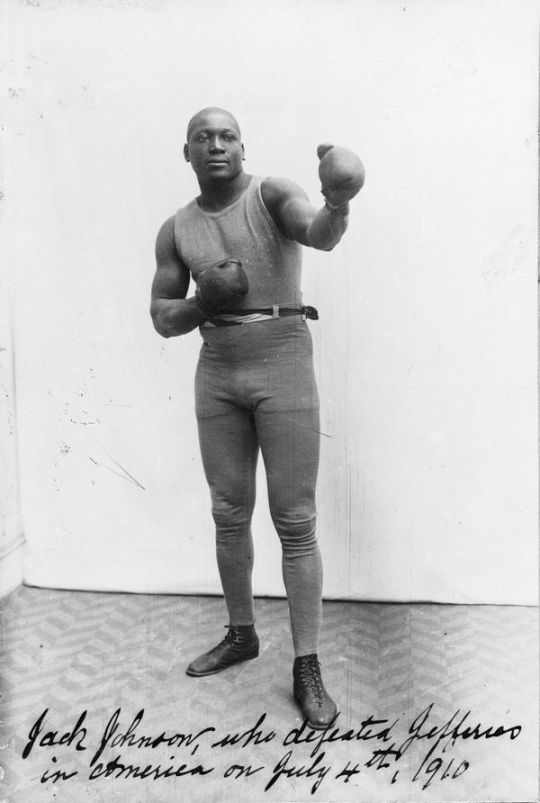
Boxer Jack Johnson
(Photo by Sean Sexton / Getty Images)

Jones in boxing attire
(Bettman via Getty Images)
Even with its flaws, there’s no question that The Great White Hope made an impact on those who saw it, on stage or screen.
“I remember walking down the streets of New York for the next decade, and black men would just come up and say, ‘Hey, Jane, how are ya?’ or something like that,” says Alexander. “I remember once I was in an airport, and Snoop Dogg yells across the terminal, ‘Jane!’ I recognized that he was a big music star, but I didn’t know who it was, so I just sort of inched over a little bit…and he just said, ‘Hey!’ That’s all! But I felt very warm inside that black men recognized me, seemed understanding and supportive, and… I think they were saying that they knew that it was a difficult role.
“It was surprising to me the number of white people who wondered why I had done the film. There were a lot of firsts there. The racism was not as overt as it is today, but it was there, and I was surprised it was there in my parents’ friends, who would just question me and say, ‘Why did you have to do that for your first film?’ I was thrilled! Race relations were different at that time. We didn’t march in the same way. If you look at the marches in Selma, Alabama, you won’t see a lot of white people. But I was part of the Poor People’s March in Washington (in 1968), and I went and listened to Martin Luther King speak. But now we have Black Lives Matter, and there are a lot of white people and black people walking side by side. That’s progress.”
#History
0 notes
Text
2017 Movie Odyssey for-fun awards
The 2017 Movie Odyssey Awards are being posted sometime soon, but, as is tradition on this blog, here are some for-fun honors and dishonors based on a year of watching 200+ films that were new to me this calendar year.
Actor I wanted to smack most in the face: Mark Wahlberg, The Happening (2008)
Good lord, he was AWFUL. “Planning on murdering me in my sleep?” “WHAT, NO!” Here’s Wahlberg talking to a plastic tree.
Attempted political messaging, but says less than it wants: State of the Union (1948)
Frank Capra, you are better than this!
Attempted religious messaging, but says less than it wants: Conflagration (1958, Japan)
Best Film Title: What Dreams May Come (1998)
Best individual cue from an original score: “End Titles” from Independence Day (1996), composed by David Arnold
Best lyrics passage from an original song: From “No Wrong Way Home” from Pearl (2016 short)
One blue-green world, round as a pearl,
doesn’t matter which road you take, you’ll wind up in the same place.
That’s not philosophy, it’s geometry,
and if things don’t look the same, well it’s only you who’ve changed.
There’s some interesting messaging and rhyming going on here. Damn.
Best Moment: An act of sportsmanship, followed by a grandstand finish, Akeelah and the Bee (2006)
If you have kids and they haven’t seen this movie, find this movie. If you haven’t seen this movie, find this movie.
Best Montage: Body-switching and “Zenzenzense”, Your Name (2016, Japan)
Best Movie Dad: Raymond from My Life as a Zucchini (2016, Switzerland)
The first non-biological father to win here, I think. It matters not, though. He is wonderful here.
Best Movie Family Member, non-parent: Aunt Mattie (Clara Blandick), A Star Is Born (1937)
For supporting Esther’s dreams of going to Hollywood without fail. You go, Aunt Mattie. She really is not in this movie long enough.
Best Movie Mom(s): All of the Boatwrights (Queen Latifah, Alicia Keys, and Sophie Okonedo) and Rosaleen (Jennifer Hudson), The Secret Life of Bees (2008)
Again, a first in that these are adopted parents. Thanks to a good friend of mine for introducing to me the book.
Best on-screen friendship: The friendship between all the orphans in My Life as as Zucchini
Best use of non-original music (and best musical callback to a past movie): The many uses of “You’ll Never Know” from Hello Frisco Hello (1943) appearing in The Shape of Water (2017)
Hello Frisco Hello remains on my watchlist… we’ll get there someday!
Best dance segment (for two): Rita Hayworth and Fred Astaire in “I’m Old Fashioned”, You Were Never Lovelier (1942)
Best dance segment (solo): Donald O’Connor in “A Man Chases a Girl (Until She Catches Him)”, There’s No Business Like Show Business (1954)
Best sword fight: Errol Flynn v. Basil Rathbone, Captain Blood (1935)
Yeah, sorry folks who expected Rey and Kylo Ren v. Praetorian Guards or Kylo Ren v. Luke here.
Bestiality: The Red Turtle (2016, France/Belgium/Japan)
SPOILERS!!!
Biggest Disappointment: Marnie (1964)
Oh god, this may be the first Hitchcock movie I truly loathed (nor do I think it will be the last… I’ve basically seen all the greats by now).
Biggest (pleasant) surprise: Pear Cider and Cigarettes (2016 short)
I was worried about the explicit content for this Oscar-nominated short film, and that it might meander around its topic a bit. But no it didn’t. Well done, well deserved nomination.
Biggest (unpleasant) surprise: Detroit (2017)
It becomes torture porn in the final third. The black victims are not nearly developed enough here as they should be.
Bloodbath: Logan (2017)
Is it the movie with the highest body count? Maybe not, considering I saw both Independence Day movies this year. But it was certainly bloody!
Bravest: Parvana, The Breadwinner (2017)
Going full-out Mulan to help her family survive in pre-American invasion Afghanistan? I was astounded by Parvana’s resilience.
Don’t take opiates, kids: Pink Floyd - The Wall (1982)
Greatest Discovery (Actor): Pierre Étaix, Yoyo (1965, France)
Greatest Discovery (Actress): Brooklynn Prince, The Florida Project (2017)
Greatest Discovery (Director): D.A. Pennebaker, Don’t Look Back (1967) and Monterey Pop (1968)
Hardest ending to watch: The Coward (1965, India)
Satyajit Ray pulling no punches here.
Hypnotic: Notes on a Triangle (1966 short)
A beautiful experimental animated short film. Someone’s going to connect it to the Illuminati or some vast Canadian conspiracy somehow.
Kept me on the edge of my seat: Seven Days to Noon (1950)
A Cold War thriller at the very beginning of the Cold War has so much going for it than so many modern thrillers can never hope to achieve.
Kick-ass moment: This riding scene from The Man from Snowy River (1982)
I’d like to see a chimpanzee with dual-wielding machine guns do that! Make it happen, 20th Century Fox!
Laziest (not worst) film title: Summer Magic (1963)
I mean, the songs are decent and Hayley Mills is, too. But come on, Disney!
Least funny comedy: That Funny Feeling (1965)
Least likely to deserve my negative review 10 years from now: Justice League (2017)
Because you know Zack Snyder will find a way to screw the DCEU up even more.
Least likely to deserve my positive review 10 years from now: I have a hunch it’s gonna be Star Wars: The Last Jedi (2017)… but I don’t want that to be official here.
Line I will repeat the most down the years: “Apes. Together. Strong.”, Dawn of the Planet of the Apes (2014) and War for the Planet of the Apes (2017)
Made fashion designers compelling: Funny Face (1957)
Most Inspiring: Swim Team (2016)
A documentary that follows three members of a New Jersey Special Olympics swim team. All those kids have autism, and it is fantastic to see them learn, grow, and live over time. It isn’t a Hoop Dreams, but it doesn’t need to be.
Made me laugh the most: Blackbeard’s Ghost (1968)
And I’m not ashamed to say that. It’s not the best comedy by any means, but I got more laughter and mileage out of this one than anything else.
Most Memorable Use of an Icepick: Scarlet Street (1945)
Don’t spoil if you know!
Most Overrated Picture: Manchester by the Sea (2016)
Casey Affleck had no business winning that Academy Award.
Most Underappreciated: The Great Man (1956)
In our world of “fake news”, this movie - which also comments on how we idealize our heroes - has many echoes on today. It’s a good journalism/news media movie, even if it’s concentrated on early TV and especially radio.
Most Underseen: Bardelys the Magnificent (1926)
A good, entertaining adventure-romance silent film with John Gilbert and Eleanor Boardman. The reason why it’s underseen was because it was considered a lost film until recently, when a near-complete print turned up in France.
Movie I most wished to write on, but wasn’t able to (because I ran out of October to do it): A retrospective on Rise of the Planet of the Apes (2011) and regular reviews for Dawn of the Planet of the Apes (2014) and War for the Planet of the Apes (2017)
Movie that I’m most eager to rewatch: Castle in the Sky (1986, Japan)
There was so much going on, and so many departures from Nausicaa that I need time to do a Retrospective review on this some day. It’s a gorgeous film.
Nearly resulted in someone killing me in a theater: In This Corner of the World (2016, Japan)
Yeah, if the main character had gone to Hiroshima, I would have been a goner (and it wouldn’t have been by my own hand).
Raunchiest: Destry Rides Again (1939)
Holy hell. There are so many entendres in here, and Marlene Dietrich is going all out on the sexuality! How did this get pass the Hays Code?
Sorry, I didn’t get it, and I still don’t get all the love for David Lynch (even though Mulholland was great): Eraserhead (1977)
Sounds most like a porno (other than Octopussy because that’s too easy): Peeping Tom (1960)
With apologies to Michael Powell.
Star Trek alumni award: Patrick Stewart, Logan (2017)
Surprisingly relevant political commentary: They Won’t Forget (1937)
Northern-Southern attitudes in the United States? Even a touch of racial relations? Now if only Warner Bros. kept the defendant in the movie Jewish, as he was in real life.
Underrated: Lonely Are the Brave (1962)
One of the best neo-Westerns you are likely to see.
Worst film title: The Hound That Thought He Was a Raccoon (1960)
For chrissakes, Disney.
Worst Moment: All the rapey-ness of Revenge of the Nerds (1984)
It reminded me why the 1980s is in contention for my least favorite decade of filmmaking.
Stay tuned, the 2017 Movie Odyssey Awards will be up shortly! Thank you all for following. Thank you all for being here for as long as you have. Thank you for supporting all this blog does.
6 notes
·
View notes